- Yachts for Sale
- Sales Report 2024
- FAQ – Luxury Crewed Yacht Charters
- FAQ – Bareboat charters
- FAQ – Sell your Boat
- FAQ – Buying a Yacht
- How Much does it Cost to Charter a Luxury Yacht?
- All Blog Posts and News
- Yachting for beginners
- Indian Ocean
- Mediterranean
- Sales & New build
- Motor Yacht
- Event & News


How is a Luxury Yacht doing in Rough Seas?
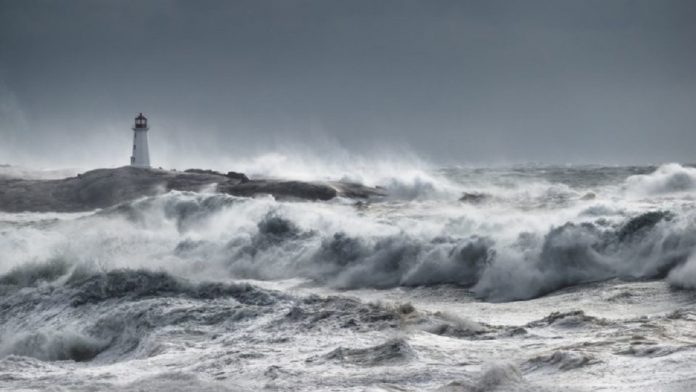
Luxury yachts are the ultimate symbol of indulgence in the world of boating. With their sleek designs, high-tech features and luxurious interiors, these vessels are ideal for those who want to experience the opulence of life at sea. However, when it comes to facing harsh weather conditions, even the most expensive yachts can be tested to their limits. The question is, how well do these luxury yachts perform in rough seas?
What can we call rough sea conditions?
Rough sea conditions refer to the state of the sea characterized by high waves, strong winds, and heavy swells. These conditions are common during storms or extreme weather events, making sailing or boating more challenging and dangerous. The height of waves during rough sea conditions can exceed 3 meters, which can cause vessels to pitch and roll, affecting the stability and safety of the crew and the yacht. Additionally, rough sea conditions can also cause high levels of water spray, making visibility difficult and reducing the effectiveness of navigation aids.
Should you expect to have rough conditions during a yacht charter?
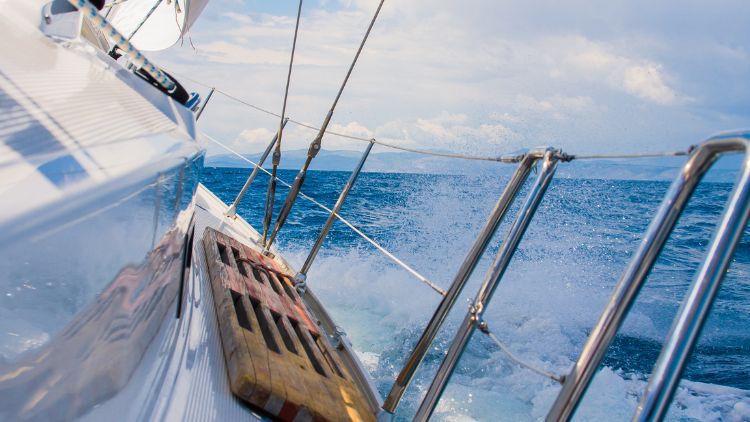
Trimarans are often considered to be some of the best performers in rough waters due to their design features. Their three-hull structure provides increased stability, reducing the rolling motion that can cause seasickness and discomfort. Additionally, the wider beam of trimarans gives them more surface area on the water, improving their stability further. Another benefit of trimarans is their ability to maintain speed in rough seas. The aerodynamic design of their hulls, coupled with the increased stability, allows them to cut through choppy waters while maintaining a relatively smooth ride.
Read also: The Caribbean To Mediterranean Sailing Routes: How To Cross The Atlantic Eastward
Most sailing yachts are resistant in difficult weather conditions
When it comes to sailing yachts, some types are better equipped to handle rough seas than others. One such type is the ocean cruiser, which is designed specifically for long-distance sailing in all conditions. Ocean cruisers typically have a heavier displacement, a deep keel, and a strong hull, which helps them to maintain stability and ride out storms. Another type that excels in rough seas is the bluewater cruiser, which is also designed for offshore sailing. These yachts feature a high freeboard, which keeps the cockpit and cabin drier in heavy seas, and a keel that is deep enough to provide good stability. Other types of yachts, such as performance cruisers or racing yachts, may not be as well-suited for rough seas, as their focus is on speed rather than durability in challenging conditions. It’s worth noting, however, that even the most seaworthy yacht can be overwhelmed in extreme weather, so it’s always important to exercise caution and good judgement when sailing in rough seas.
Motoryachts, especially superyachts and megayachts handle rough sea really well
When it comes to handling rough seas, luxury motor yachts come to the forefront with their exceptional seaworthiness and stability. Superyachts and megayachts, with their larger size and weight, offer a smoother ride in choppy waters. The deep-V hull design found in these larger yachts helps them cut through the waves with ease, reducing the impact of a rough sea. Additionally, these boats often feature advanced technology and stabilisation systems that further minimise uncomfortable motion.
Which types of yachts are the most uncomfortable in rough conditions?
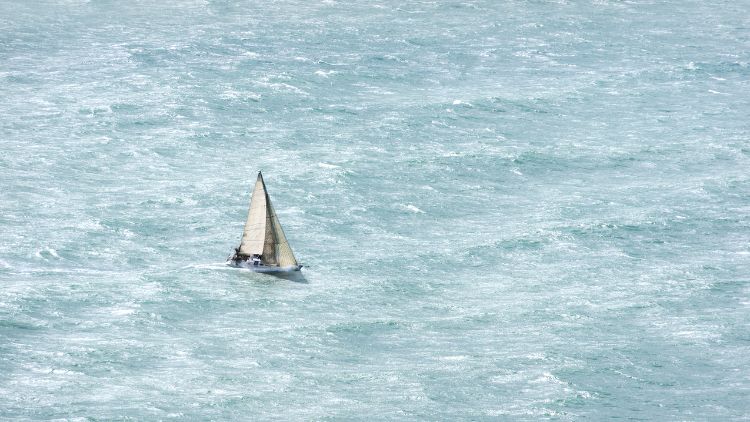
Catamarans are notoriously uncomfortable once the sea is getting too wild
When it comes to yachts and rough conditions, certain types are more prone to discomfort than others. Catamarans, for example, are often cited as being particularly uncomfortable during rough seas. This is due to their design – catamarans feature two parallel hulls that sit above the water. While this design can provide increased stability in calmer waters, it can pose problems when the sea gets choppy. Because the hulls are separate, rather than being connected like a traditional single-hulled yacht, the boat can bounce around more, leading to a rougher ride. Of course, the severity of discomfort will depend on a variety of factors, including the size of the catamaran, the strength of the waves, and the experience of the captain. However, if you know you’re headed into rough waters, it’s worth bearing in mind that a catamaran may not be the most comfortable option.
Monohulls will tilt drastically in bad weather conditions
Monohull yachts are generally considered the most uncomfortable in rough weather conditions. This is because monohulls are more susceptible to tilting or heeling dramatically when the waves become choppy, leading to a much more unstable and uncomfortable ride for those on board. In some cases, the boat may even list to one side or the other, causing occupants to struggle to maintain balance and potentially leading to seasickness. In contrast, multihull yachts such as catamarans are generally considered more stable and comfortable in rough conditions, as their wider hulls and lower center of gravity help them to better withstand the effects of wind and waves..
Read also: Best yachts for transatlantic: our selection and advices
What does it feel like to be in a yacht while the sea is rough?
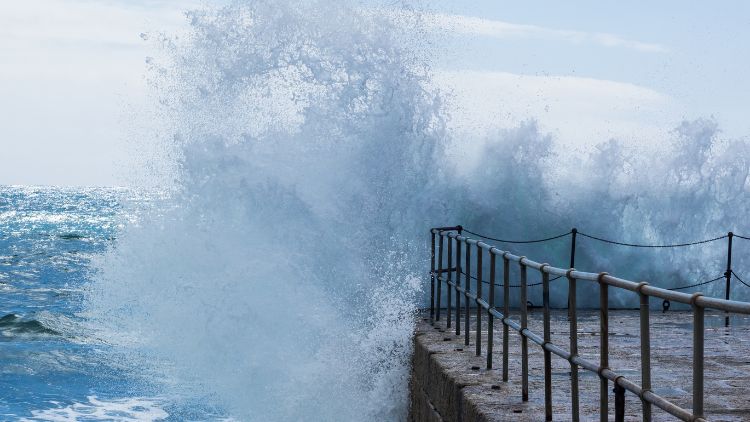
On this page:
13 examples of best sailboats for rough seas, key characteristics of sailboats for rough sea conditions, the best hull design and types for rough sea conditions, the best sailboat rig type for rough sea conditions, the most ideal keel type for sailboats in rough seas.
Here are 13 examples of sailboats for rough seas that you might want to consider:
| Twin-hull design provides excellent stability and reduces rolling in rough seas | |
| Narrow beam and heavy displacement make it very stable in heavy seas | |
| With a long keel for better directional stability during rough sea events | |
| Deep-V hull design and heavy displacement provide excellent stability and a smooth ride in rough seas | |
| Monohull sailboat with a fin keel for maneuverability in rough seas | |
| Heavy displacement and full keel provide excellent stability and tracking in rough seas | |
| Heavy displacement and centerboard keel provide excellent stability and tracking in rough seas | |
| Long keel and heavy displacement provide excellent stability and tracking in rough seas | |
| Has a fin keel for easy maneuverability in rough seas | |
| Heavy displacement and full keel provide excellent stability and tracking in rough seas | |
| Heavy displacement and full keel provide excellent stability and tracking in rough seas | |
| It has a fin keel that makes it easy to handle in heavy winds | |
| Deep-V hull design and heavy displacement provide excellent stability and a smooth ride in rough seas |
1. Prout Snowgoose 37: This is a real blue water cruising boat that is perfect for experienced multi-hull sailors who have cruised across the Atlantic. It is also a great option for those who are new to sailing on rough seas.
2. Moore 24: Designed by the legendary California sailor and surfer George Olson, the Moore 24 is one of the first ultra-light displacement sailboats. It is a fast, fun speedster that is perfect for downwind sailing.
3. Mariner 36: This is a classic cruising sailboat that is known for its durability and seaworthiness. It is equipped with a long keel which provides better directional stability than a similar boat with a fin keel.
4. Cal 34: This is a popular sailboat that is known for its performance in rough seas. It has a fin keel that makes it easy to handle in heavy winds.
5. Morgan 43: This is a monohull sailboat designed by Nelson Marek. It has a fin keel that provides maneuverability in rough seas.
6. Swan 43: This is a high-performance sailboat that is perfect for racing and cruising. It has a sleek design and a fixed, swept fin keel.
7. Bermuda 40: This is a classic sailboat that is known for its traditional design and seaworthiness. It is equipped with a centerboard keel, which is a pivoting lifting keel, allowing it to sail both coastal and inland waters.
8. Island Packet 26: This is a popular cruising monohull sailboat that is known for its spacious interior and comfortable ride. It has a long keel that provides stability in rough seas.
9. Mariner 47: This is a classic cruising sailboat that is known for its righting capability if capsized. It is equipped with a fin keel that provides splendid maneuverability.
10. LeComte Northeast 38: This is a classic sailboat that is known for its traditional design and seaworthiness. It has a full keel that provides stability in rough seas.
11. Westsail 32: This is a classic cruising sailboat that is known for its strength and durability. It has a full keel that provides stability in rough seas.
12. Dana 24: This is a popular cruising sailboat that is known for its performance in rough seas. It has a fin keel that makes it easy to handle in heavy winds.
13. J/35: This is a high-performance sailboat that is perfect for racing and cruising. It has a sleek design and a deep keel that provides stability in rough seas.
Now here are the essentials characteristics of the ideal sailboat for rough sea conditions:
- A sturdy and well-built hull that can withstand the impact of waves
- A deep keel that provides stability and prevents capsizing
- A strong and reliable rigging system that can handle high winds
- A well-designed deck that provides ample space for the crew to move around safely
- A comfortable and secured cockpit that keeps the crew protected from the elements
- A reliable engine that can be used in case of emergency
Rough sea conditions can be caused by a variety of factors, such as high winds, storms, and tides. High winds can create large waves that can be difficult to navigate, while storms can bring heavy rain, lightning, and unpredictable winds. Tides can also create rough seas, especially when they're opposing the wind direction.
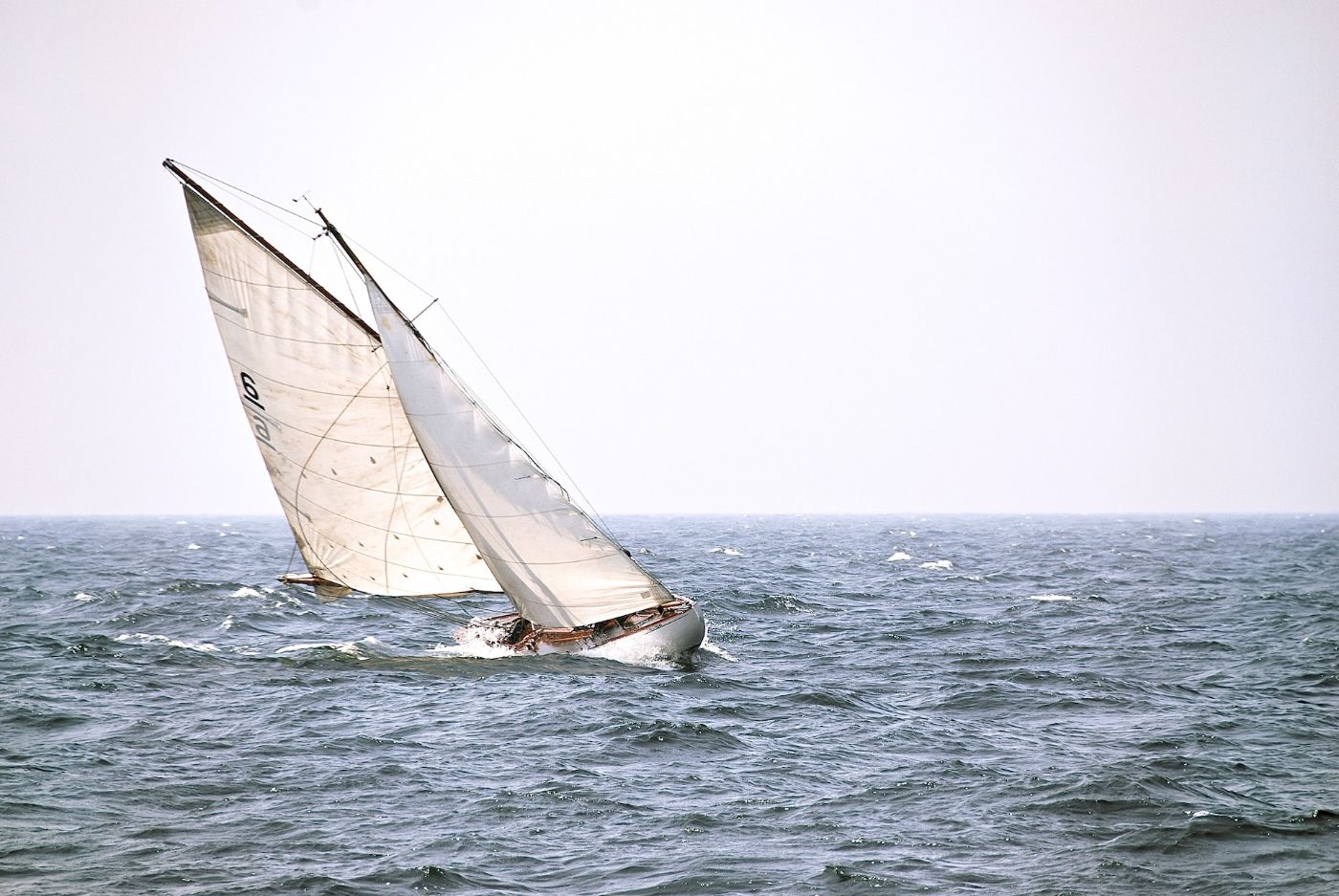
When sailing in rough seas, you might need to keep in mind that your sailboat will be subjected to constant motion , which can be uncomfortable and even dangerous if you're not prepared. Your sailboat must be able to handle the rough sea conditions and keep you safe.
The sailboat needs to be highly stable
A stable sailboat will be less likely to capsize or roll over in high waves. Look for sailboats with a low center of gravity and a wide beam ratio for added stability. Sailboats with a beam ratio of at least 3:1 have improved stability and comfort.
The boat must have essential safety features
You can check if the sailboat has adequate safety features, such as a sturdy hull, strong rigging, and proper safety equipment. Additionally, consider the sailboat's ability to self-right if it capsizes.
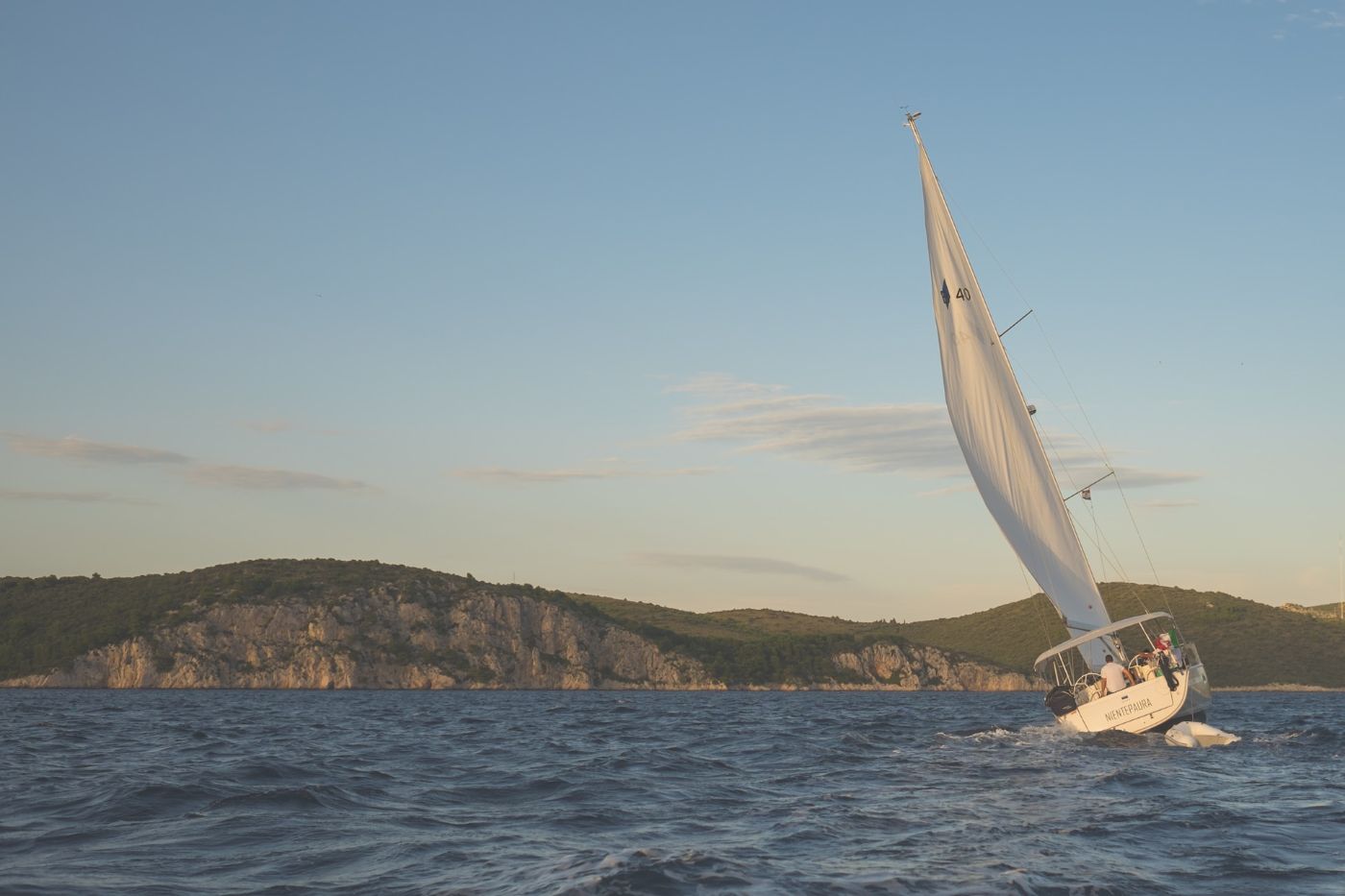
The sailboat must be comfortable enough
Some sailboats are designed to provide a smoother ride. Look for sailboats with a deep V-shaped hull and a high deadrise angle for improved comfort in choppy waters.
The deadrise angle is the angle between the hull and the waterline. A high deadrise angle can help a sailboat cut through waves more efficiently, providing a smoother ride in rough seas.
The boat must have improved speed when necessary
Speed is not always a top priority when sailing in rough seas, but it can be important in certain situations. For example, if you need to outrun a storm or reach a safe harbor quickly. Look for sailboats with a high buoyancy-to-weight ratio and a planing hull for improved speed in rough conditions.
The sailboat should stay afloat
Buoyancy is critical when sailing in rough seas. A sailboat with high buoyancy will be more likely to stay afloat in high waves. Look for sailboats with a displacement-to-length ratio of 100 or higher for improved buoyancy.
Here are different types of hull designs available, and each has its advantages and disadvantages:
| Single hull | Stable and maneuverable | Less stable in rough seas | |
| Two or more hulls | Greater stability and speed | Requires more maintenance | |
| V-shaped hull | Cuts through waves and provides a smooth ride in rough seas | Less stable in calm waters | |
| Slightly modified V-shaped hull | Offers good stability and maneuverability in rough seas | Less efficient at high speeds | |
| Flat bottomed hull | Good stability in calm waters | Less efficient and uncomfortable in rough seas | |
| Rounded hull | Good stability at high speeds | Less stable in rough seas | |
| Two parallel hulls connected by a deck | Stable and fast | Can be expensive | |
| Three hulls with the main hull in the center | Fast and stable | Can be difficult to maneuver in tight spaces |
The best hull design type for sailboats in rough sea conditions is a deep-V hull or a modified-V hull. These hull designs are able to cut through waves and provide a smooth ride, even in choppy waters.
They also offer good stability and maneuverability, which are important in rough seas. Other hull designs, such as catamarans and monohulls , are also effective in rough sea conditions. Catamarans have more roll stability, while monohulls are better at upwind sailing.
If you want a more detailed discussion on hull designs and types, you can try reading this article.
In this section, we will discuss the three most common rig types: Sloop, Ketch, and Cutter.
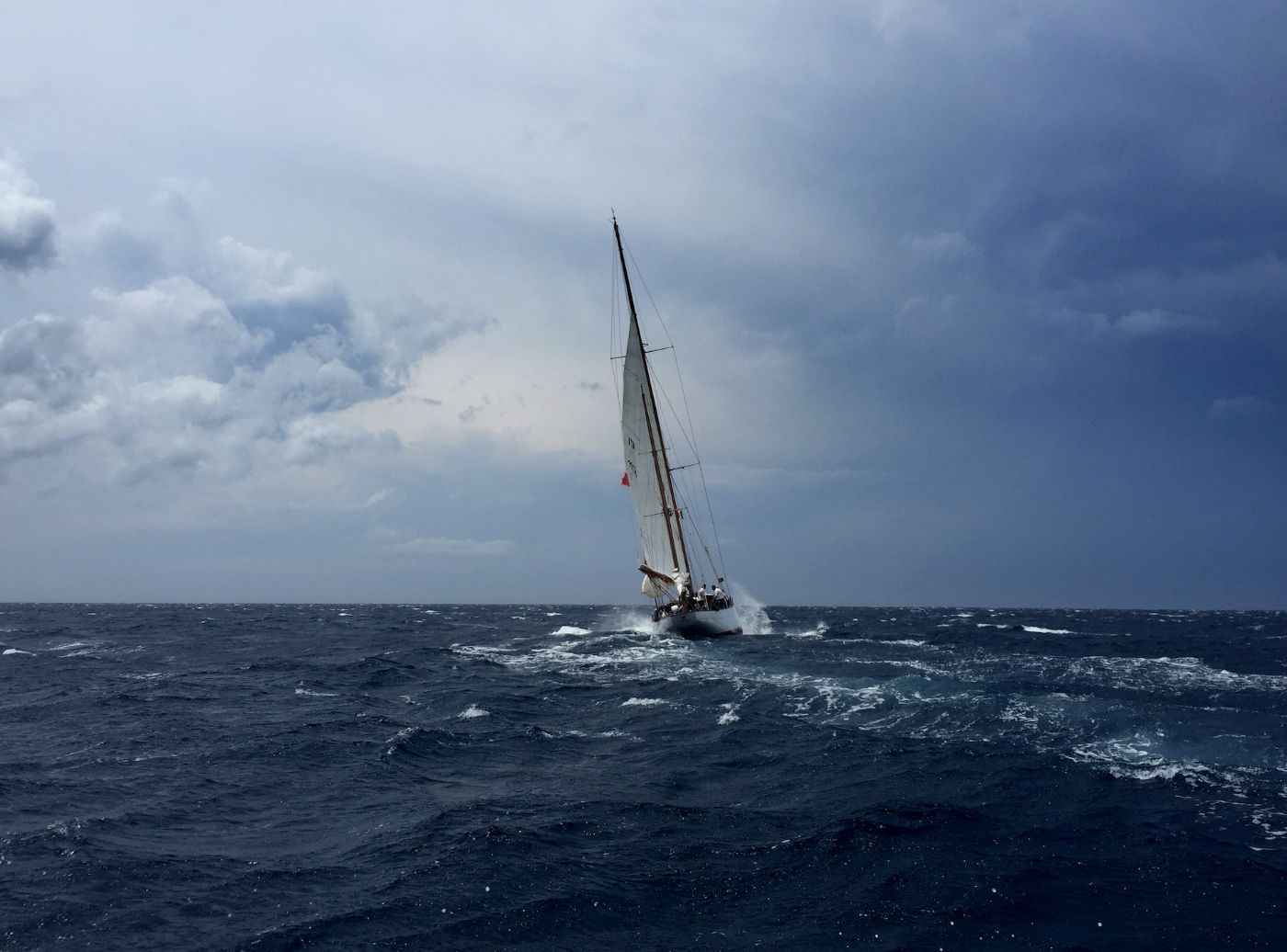
The sloop rig is the most common rig type
The sloop rig is often used on sailboats of all sizes. It consists of a single mast with a mainsail and a headsail. The mainsail is typically larger than the headsail, and the sail plan is designed to be easily managed by a small crew. The sloop rig is known for its simplicity and ease of handling, making it a popular choice for both cruising and racing.
Ketch is more advantageous in rough seas
The ketch rig is similar to the sloop rig, but it has two masts. The mainmast is taller than the mizzenmast, and both masts have their own sails. The mainsail is typically larger than the mizzen sail, and the mizzen sail is located aft of the cockpit.
The ketch rig is known for its versatility and ability to handle a variety of wind conditions. It also provides more sail area than a sloop rig, which can be advantageous in rough seas. However, they can be more complex to manage than a simple sloop rig and requires more crew members to handle the sails.
The cutter rig can sail upwind
The cutter rig is a type of rig that features a single mast with two headsails. The mainsail is typically smaller than the headsails, and the sail plan is designed to provide maximum power and speed in all wind conditions.
The cutter rig is known for its ability to sail upwind, making it a popular choice for offshore cruising and racing. It is also known for its stability in rough seas, as the multiple headsails provide more control over the boat's direction.
A more detailed discussion of different types of sail rigs can be found in this article.
The best keel type for sailboats in rough sea conditions is full keel because it provides excellent stability and directional control. It extends the length of the boat and is typically deeper than other keel types, providing a large surface area to counteract the force of the waves.

This design also helps to distribute the weight of the boat evenly, which reduces the risk of capsizing. It also provides a straighter and more predictable path through the water , which makes it easier to maintain course and avoid being pushed off course by waves.
This is particularly important in rough sea conditions where waves can be unpredictable and may come from multiple directions. Other keel types, such as fin keels or shoal draft keels, may be more suitable for calmer waters or shallow depths, but may not offer the same level of stability and control in rough sea conditions.
Leave a comment
You may also like, guide to understanding sail rig types (with pictures).
There are a lot of different sail rig types and it can be difficult to remember what's what. So I've come up with a system. Let me explain it in this article.
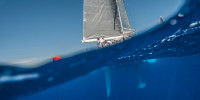
Sailboat Keel Types: Illustrated Guide (Bilge, Fin, Full)
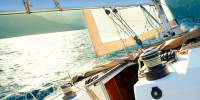
5 Surprising Advantages of a Full Keel Sailboat

The Illustrated Guide To Boat Hull Types (11 Examples)
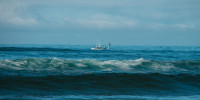
Here Are the Most Stable Boat Hull Designs (with Examples)
Can a luxury charter yacht survive rough seas?
- Inspiration
Related News
Popular news this week, popular news this month, latest news.
- Yacht Charter & Superyacht News >
Written by Rachael Steele
When it comes to someone’s first holiday on the water, one of the questions that might be racing through his or her mind is: ‘Can the luxury charter yacht survive rough seas’?
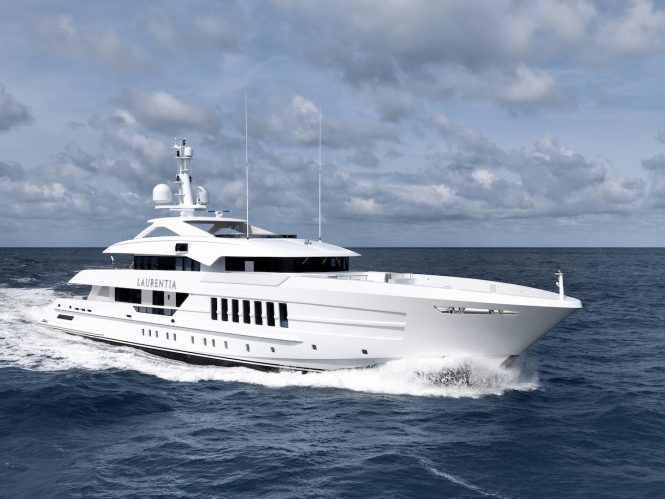
Charter yacht Laurentia
The short answer is ‘yes’, however, this might not reassure the underlying concern of what it takes to damage a vessel to such an extent that the crew and guests are in danger, and a more in-depth look at the situation is required.
Different vessels have different methods other than ballast for ensuring stability in the water: Sailing yachts have keels while motor yachts have stabilisers that reduce the pitch and roll while at anchor (known as ‘zero speed stabilisers’), and some versions can be used even while cruising. Expedition yachts are even expected to encounter rough seas on journeys to remote destinations and are equipped accordingly.
Catamarans and trimarans will have even greater stability, and these vessels are a popular choice for cruising in the Caribbean and Bahamas, where the shallow draft grants access to tranquil anchorages close to the shores.
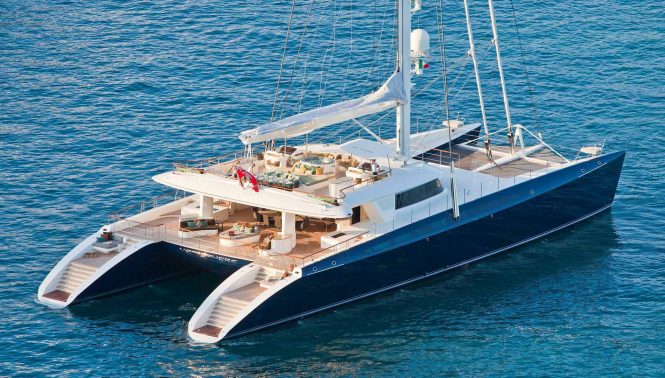
Luxury charter catamaran Hemisphere
During the construction of each unique hull design, naval architects and engineers undertake tank tests to ensure the seaworthiness of the vessel. The Douglas Sea Scale defines ‘rough seas’ as 2.5-4m/4.1-8.2ft with very rough conditions being 4-6m/13-20ft.
At Southampton University tank tests showed that when a wave was 30% as high as the hull length, it was possible to capsize some yachts. However a wave as high as 60% of the hull length capsized all vessels. So the size of a vessel also plays a role in its stability and safety on the water.
For example, to cause danger to a motor yacht of 30m/98ft, a wave must be at least 9m/29ft and as high or higher than 18m/58.8ft to sink the vessel – these wave sizes correlate to the Very High and Phenomenal categories at the top of the Douglas Sea Scale and are unlikely to be encountered unless in hurricane conditions. Under these circumstances, you’d be much happier aboard your sailing yacht or motor yacht than one of the fishing boats in the Cyclades harbours!
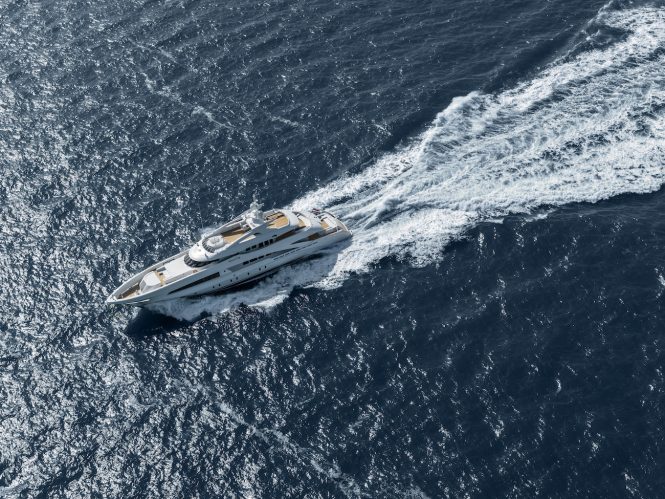
Modern yachts are designed to survive rough seas
However, it is unlikely that you will encounter such conditions during your luxury yacht charter: The Captain receives a daily weather report and will be aware of nearby ports and other sheltered anchorages to wait out the storm, and your professional crew will ensure the safety of everyone on board. Although rough to very rough conditions will make life on board unpleasant for guests and crew alike, both sailing yachts and motor yachts are prepared for such weather.
CONTACT CHARTERWORLD TO ASK ANY QUESTIONS ABOUT A PRIVATE YACHT CHARTER
Please contact CharterWorld - the luxury yacht charter specialist - for more on superyacht news item "Can a luxury charter yacht survive rough seas?".
- Charity & Fund Raising
- CharterWorld News
- Classic Yachts
- Coronavirus
- Cruise Ship
- Ecological Yachts
- Expedition Yachts
- Expert Broker Advice
- Feature Superyachts
- Interior Design
- Legal & VAT Yacht Issues
- Luxury Catamarans
- Luxury Gulet
- Luxury Phinisi
- Luxury Trimarans
- Luxury Yacht Design
- Luxury Yachts
- Marinas & Harbours
- Marine Ecology
- Marine Electronics
- Marine Equipment
- Mega Yachts
- Modern Yachts
- Motor Yachts
- New Launch Yachts
- New To Charter
- Open Style Sports Yachts
- Private Jets
- Sailing Yachts
- Social Media
- Sports Yachts
- Superyacht Crew
- Superyacht Photographers
- Superyacht Products & Supplies
- Superyacht Refits
- Superyacht Reviews
- Superyachts
- Uncategorized
- Yacht Builders
- Yacht Charter
- Yacht Charter Destinations
- Yacht Charter Picks
- Yacht Charter Specials
- Yacht Delivered to Owner
- Yacht Designers
- Yacht Events & Boat Shows
- Yacht Fashion
- Yacht Industry News
- Yacht Photos
- Yacht Racing
- Yacht Racing & Regattas
- Yacht Safety Equipment
- Yacht Support Vessels
- Yacht Tenders
- Yacht Videos
- Yachting Associations
- Yachting Awards
- Yachting Business
- Yachts For Charter
- Yachts For Sale
Quick Enquiry
Superyacht news:.
Email Your Yachting News to: news @ charterworld.com
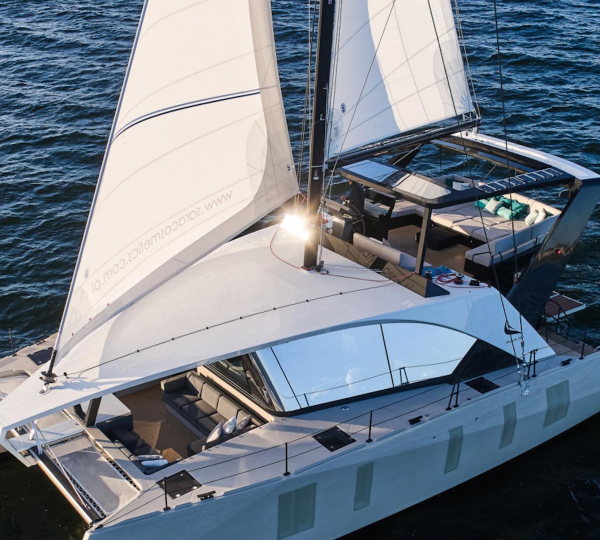
The Caribbean

New Luxury Crewed Yachts Available for Charter
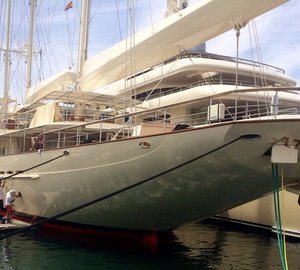
Outstanding 90m Mega Yacht ATHENA coated by Zytexx
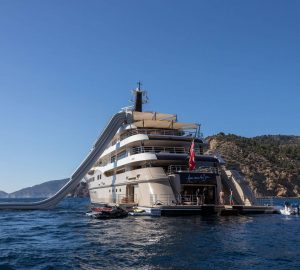
Top 10 most luxurious charter yachts from 2017
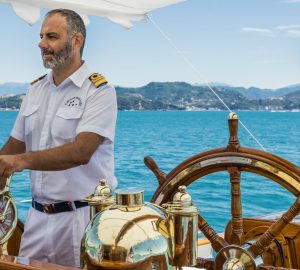
Top 10 charter yachts with classic interior
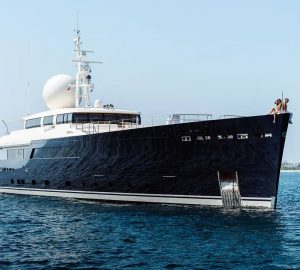
Motor yacht GALILEO in the Maldives until October 9th offering 10% off remaining weeks
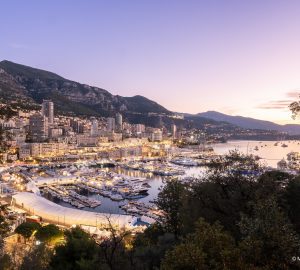
2024 MONACO YACHT SHOW: Only two weeks to go before the superyachts dock at Port Hercule
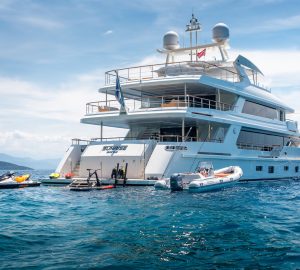
Charter special offer on board 43m luxury yacht SUNRISE
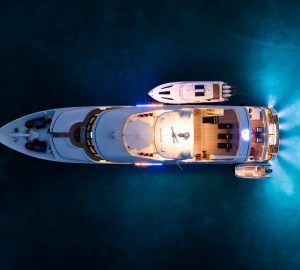
Superyacht Charters: A luxury alternative to celebrating Christmas and New Year at home
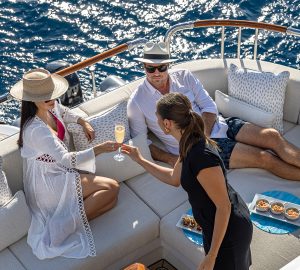
Yacht Charter Etiquette: Essential advise for a seamless travel experience
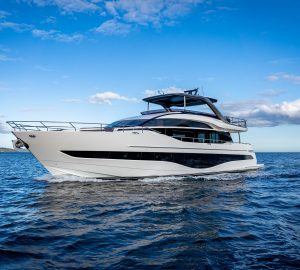
Luxury motor yacht SIDURI III for charter in the Western Mediterranean

10 sensational superyachts with spectacular swimming pools
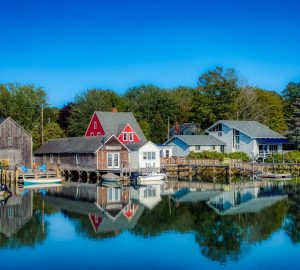
A luxury charter yacht is the perfect way to encounter New England’s fall foliage display
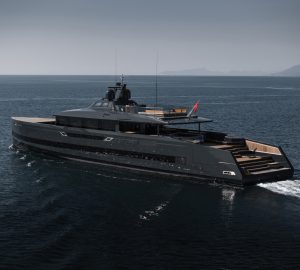
45m custom superyacht SAN will debut at the 2024 Monaco Yacht Show
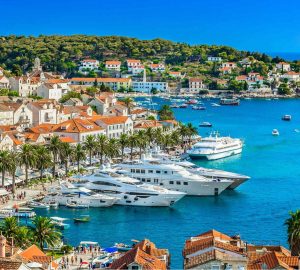
Inaugural CROYA Charter Show announced for 4th to 6th October 2024 in Split, Croatia
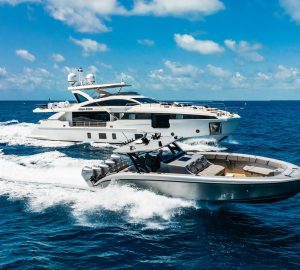
31m luxury yacht CARPE DIEM available for charter in the Bahamas
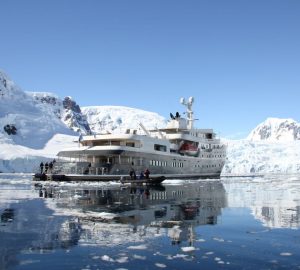
Charter yachts offering citizen science opportunities around the world
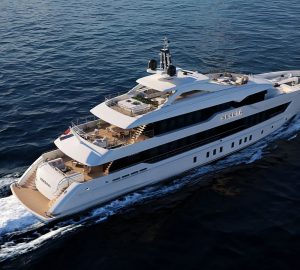
55m superyacht YN20555 is launched by Heesen Yachts and named superyacht SERENA
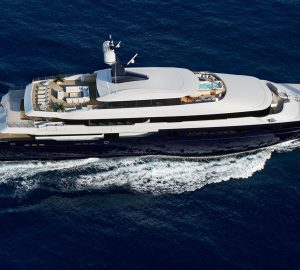
Late summer special offer on board 72m superyacht ARBEMA in the Western Mediterranean
Yachting World
- Digital Edition

Video: 6 of the best heavy weather sailing videos
- Harriett Ferris
- June 18, 2017
Watch our pick of the most dramatic heavy weather videos

This first video of heavy weather sailing is our from our Storm Sailing Series with Skip Novak . It was probably the most ambitious project Yachting World has ever undertaken: to head for Cape Horn with high latitudes doyen Skip Novak to make a series on Storm Sailing Techniques . Here is one of our most popular videos, rounding Cape Horn in Storm Force 10 conditions…
Hallberg Rassy are known for being heavy, sturdy, seaworthy boats. This video shows Hallberg Rassy 48 Elysium in heavy weather off Cape Gris Nez, northern France in 2014. The yacht seems to be handling well, able to use a Raymarine lineair 7000 autopilot depsite the conditions.
This compilation is from the BT Global Challenge round the world race, a crewed race westabout the prevailing winds in one-design steel 72-footers. It took amateur crews upwind through the Southern Ocean from Cape Horn to New Zealand and from Australia to Cape Town. This footage shows some of the weather they experienced and what the crews endured – and watch out for some footage of the race leaders fighting it out under trysail during a severe storm in the Cook Strait in New Zealand.
Single-handed sailor Berthold Hinrichs sailing in Hinlopenstretet. It is the 150km long strait between Spitsbergen and Nordaustlandet in Svalbard, Norway and can be difficult to pass because of pack ice.
A fun compilation video of sailing in strong breeze including 2 wipeouts, 1 dismasting and 1 guy going for a swim…
Our last example comes from popular YouTube channel Sailing SV Delos , as the crew tackle a 50-knot gale on the crossing to Madagascar. Skip to 8:00 for the stormy stuff:
If you enjoyed this….
Yachting World is the foremost international magazine for bluewater cruisers and offshore sailors. Every month we have practical features to help you plan and prepare to realise your sailing dreams. Build your knowledge month by month with a subscription delivered to your door – and at a discount to the cover price. S ee our latest offers now.
- 2024 BOAT BUYERS GUIDE
- Email Newsletters
- Boat of the Year
- 2024 Freshwater Boat and Gear Buyers Guide
- 2024 Boat Buyers Guide
- 2024 Water Sports Boat Buyers Guide
- 2024 Pontoon Boat Buyers Guide
- Cruising Boats
- Pontoon Boats
- Fishing Boats
- Personal Watercraft
- Water Sports
- Boat Walkthroughs
- What To Look For
- Watersports Favorites Spring 2022
- Boating Lab
- Boating Safety
- Ultimate Boating Giveaway

The Best-Riding Center Console Boats for Rough Water
- By Heather Steinberger
- Updated: April 7, 2020
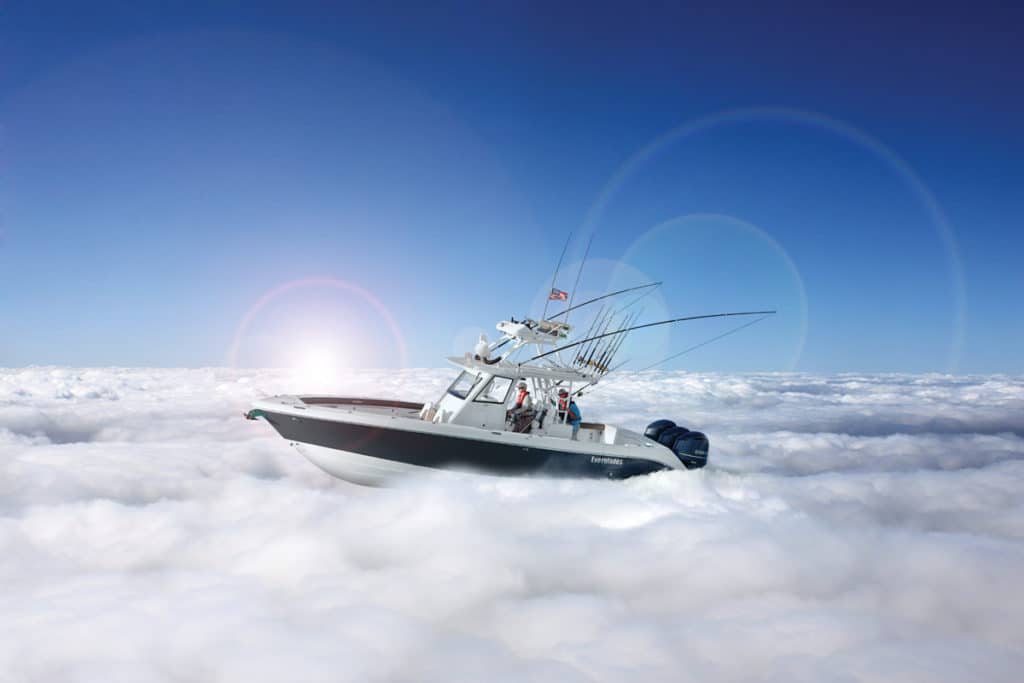
We’ve all been there. A headwind pipes up, and choppy, rough seas dance between you and your destination. You throttle up; you throttle back. You try to help your boat find its comfort zone, and you do your best to quarter the waves.
Inevitably, though, there are those stomach-dropping lurches and the slamming that clenches your muscles and rattles your dental work. Despite your best efforts, you can’t ignore the bangs down below, the ones that make the hull shudder. The ones that make you fervently hope that everyone involved with building this boat did a good job.
That’s a rough ride, even for a rough water boat. And it has happened to all of us, so let’s be honest. Not every boat can provide a soft, smooth ride in snotty conditions, no matter what the glossy brochures say.
We asked three prominent boat designers, and their answers provided much food for thought — regarding how to choose a vessel that’s going to provide a smooth ride, best boat for rough seas, the compromises and trade-offs inherent in your choice, and whether a smooth ride is even what you should be looking for in the first place.
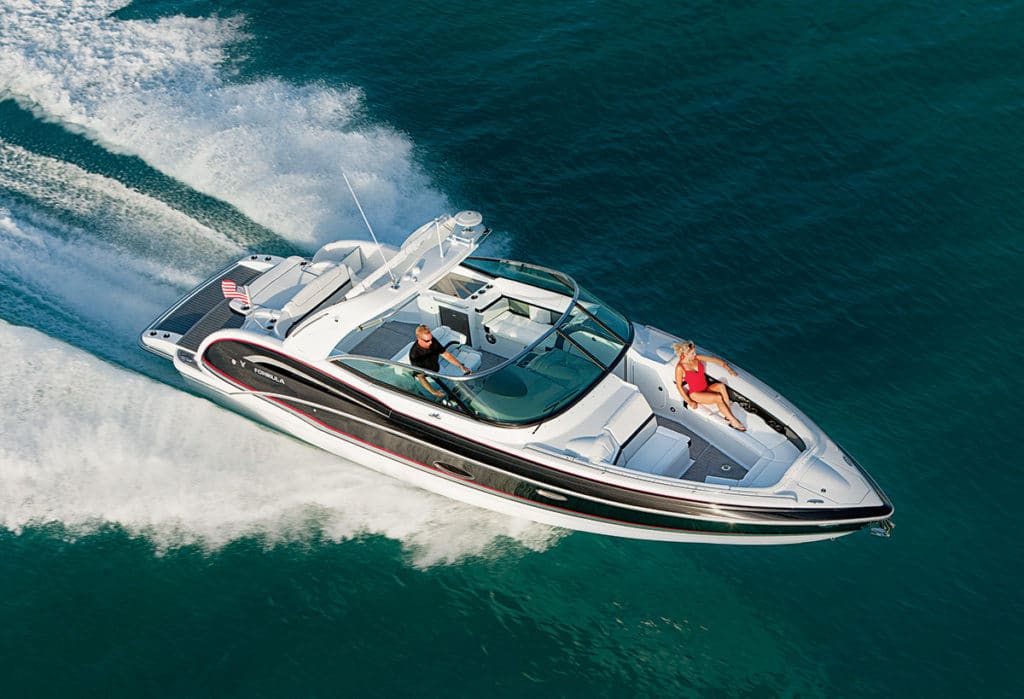
Comparing Displacement and Planing Boat Hulls
Dave Gerr founded New York City-based Gerr Marine Inc. in 1983. He’s designed a broad range of recreational boats and commercial vessels, both monohull and multihull. When it comes to designing a soft-riding hull, he immediately pointed out that there are different sets of criteria for displacement hulls and planing hulls.
Displacement hulls, he noted, don’t pound the way a planing hull will, so they automatically provide a softer ride. To maximize this, designers need to ensure three things: a good roll time, good heave characteristics and deadrise forward.
“For the roll time, we have a formula,” Gerr said. “Every boat has a natural roll period, which is 1 to 1.1 seconds times the boat’s beam in meters. If it’s slower than that, you’ll get that drunken motion. If it’s faster, it’s going to feel snappy and uncomfortable.”
For example, a boat with a 6.7-foot beam ideally should have an approximately two-second roll time. And, Gerr added, a reasonable deadrise forward will make the vessel even more comfortable.
The formula for heave, however, is more complicated. It involves the weight of the boat and the water plane area. The lighter the boat is, and the greater its water plane area, the greater the heave motion will be.
“A wide boat with a large water plane will bounce up and down violently,” Gerr said, “but if you have a small water plane compared to the boat’s weight, that heave will be slow. If it heaves too slowly, you’ve got a wet boat.
“You want to have your roll time and heave in the target region, and then add that deadrise forward,” he continued, “so you won’t have pounding in chop.”
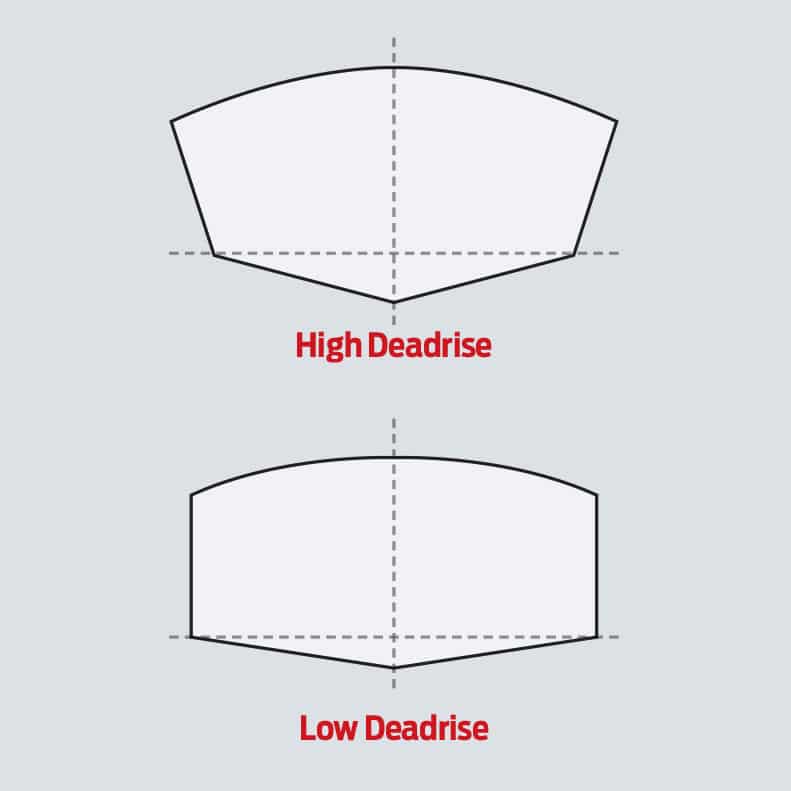
For a planing hull this is hard to achieve. By nature, these hulls are snappy and heave more while trolling or drifting; planing cancels that out, but you can still pound.
“What you really want is more deadrise,” Gerr said. “Just remember: The greater the deadrise, the slower the boat [for the same weight and engine]. That deep-V hull is going to need more power.”
A designer, he said, has to juggle power and what is good deadrise on a boat for optimum comfort.
“You put a deep, high deadrise at the forefoot to get the boat to lift its bow out of the water, or you’ll have steering problems,” he said. “You design it so it planes higher, and then you control it with trim tabs so you won’t trip over that forefoot.”
Deadrise is a difficult thing to visually assess at a boat show or in a dealer’s showroom, so how can a boater ascertain if a soft ride was a design priority? Gerr said the length-to-beam ratio is a dead giveaway.
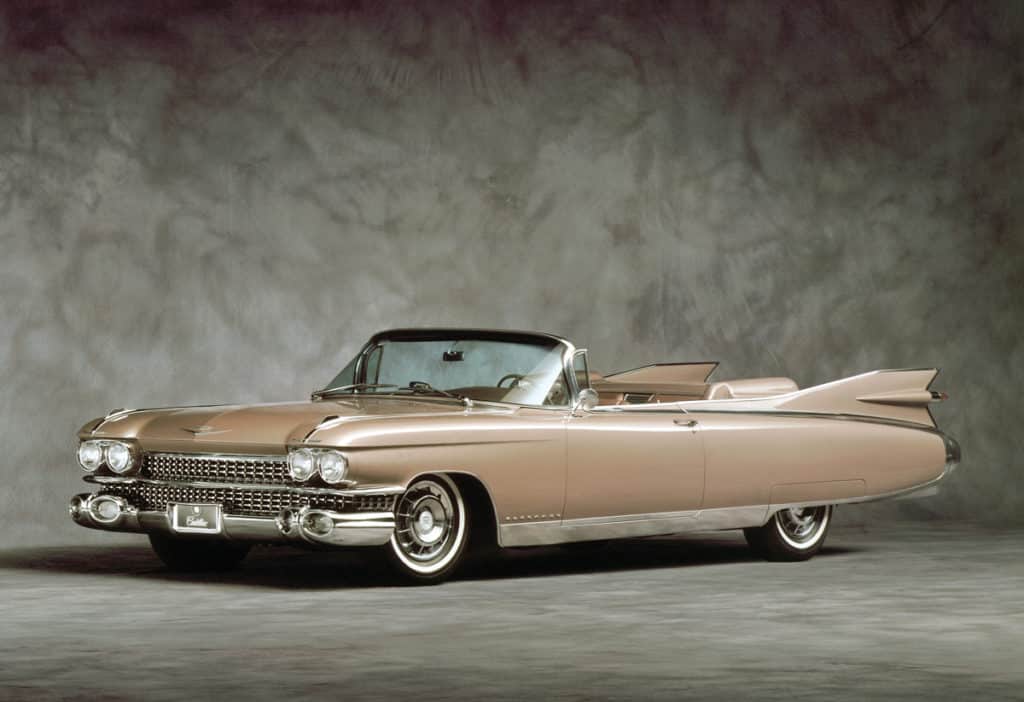
“A long, slender hull is going to have a softer ride, as long as the designer got the roll time right,” he stated. “A wide, shallow hull isn’t going to perform as well. And if you’ve got a high superstructure, you’re going to have increased roll and handling problems.”
Of course, less displacement means it’s a smaller boat inside. You’re going to have to go longer to get the same live-aboard space as that shorter, wider, taller boat next door, but the good news is that your boat is going to be faster and more fuel-efficient than the fat, high version of the same length.
If you are talking deadrise, Gerr said he likes to see a minimum of 17 degrees for offshore boats, although he observed that’s still a bit shallow. Deep-V hulls are considered to be 21 degrees or more. Consider this if you’re looking for the best deadrise for rough water.
“I’d say look for a deadrise of more than 20 degrees,” he advised, “and a length-to-beam ratio on the waterline that is greater than 3.5 to 1. Those two characteristics give you a pretty good idea that the design is intended for a soft ride.”
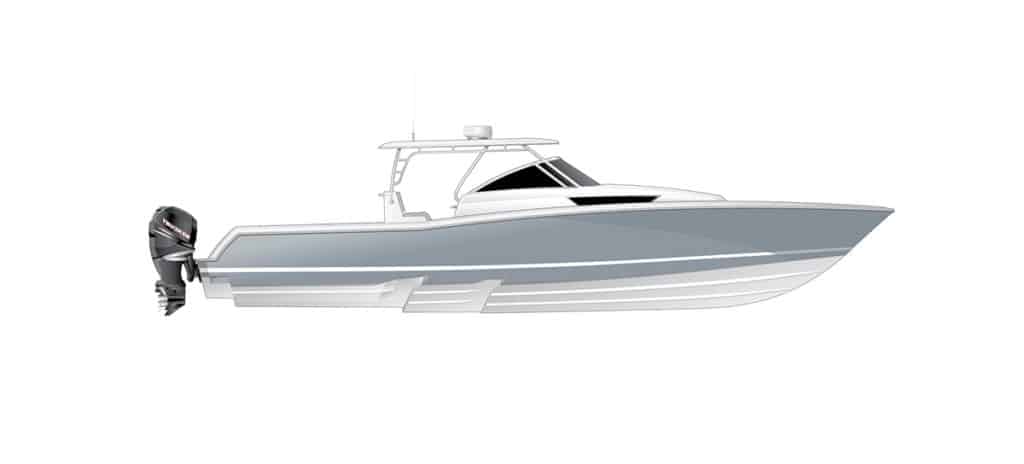
How Does a Boat Hull Handle in Following Seas?
Michael Peters founded Sarasota, Florida-based Michael Peters Yacht Design (MPYD) in 1981. Originally specializing in high-speed boats and offshore racing, MPYD now brings its fusion of performance and aesthetic standards to a wide variety of boat designs. When asked about the search for the perfect soft-riding boat, Peters laughed.
“Think of these ideals: soft-riding, dry and fast,” he said. “Now, pick two.”
The softer-riding a boat is, the wetter it is, because it doesn’t confront the wave. Rather, it splits it. If you want to knock the water down and push it away, then you’ll feel the impact. Boaters clearly need to consider these trade-offs when seeking a soft-riding vessel, but Peters has a more important cautionary tale to share. It’s natural to think of head seas and a soft-riding hull together in the same scenario — but what happens when the boat turns around?
“That’s a different story,” Peters said. “Following seas can pick up the stern, and the sharp angle and deadrise can cause the boat to bow-steer and broach. That’s a much more dangerous situation. It’s uncomfortable to hit the seas on the nose, but it won’t kill you. Boats go out of control in following seas, not head seas.”
Simply put, a hull that is too pointy forward and too flat aft will have an increased risk of broaching. Boaters should look for a hull with deadrise spread evenly — no extremes, such as a professional offshore racing boat’s sharp deadrise throughout the hull. The best boat hull for rough seas must be able to handle following seas.
“If you’re going to have fine forward sections, you’ll balance the hull by putting a lot of deadrise aft,” Peters explained. “You’re looking for recovery, a bow that doesn’t plunge and that can regain its buoyancy in a following sea.
“In our forward sections, we always run a convex section that’s puffed out,” he continued. “Some curvature helps dissipate wave energy and impact. Concave sections look like they’ll provide a softer ride, but they actually focus the energy.”
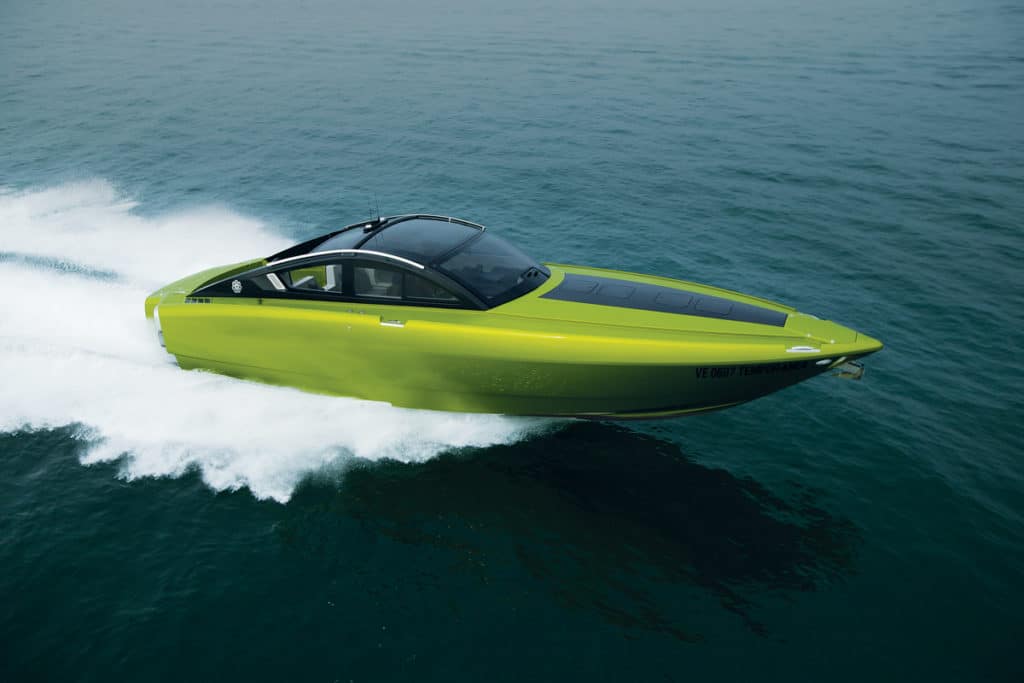
Peters’ advice to boaters is twofold. First, avoid those extremes. They’re not necessary for most recreational boaters. And second, make sure you have a good grasp of where and how you’re going to use the boat. An offshore cruising boat might not be the best choice for a river or inland lake.
“Lakes can be much harder for running a boat than the ocean, where you have long swells rather than steep, breaking seas,” Peters said. “Just make sure you’ve planned for the worst conditions you’ll run in, not the best, and never, ever sign a contract without running the boat in the intended conditions.”
Some boats, he said, are not designed to be the best boat . Sometimes the goal is to provide the best accommodations for the hull’s length and beam, which can mean creating a vessel that has a lot of windage, high freeboard, a high center of gravity and a very wide beam for its length.
“We don’t get to design the best boat in all cases,” Peters said. “No perfect boat? No kidding. But every boat appeals to somebody. One guy might love this particular boat, and he wants that 6-foot-4-inch headroom, while another guy is going to hate the compromises.”
“You always have to be aware that the more you emphasize space, the less boat it’s going to be,” he warned. “And it’s counterintuitive, but what looks good might not be good at all.”
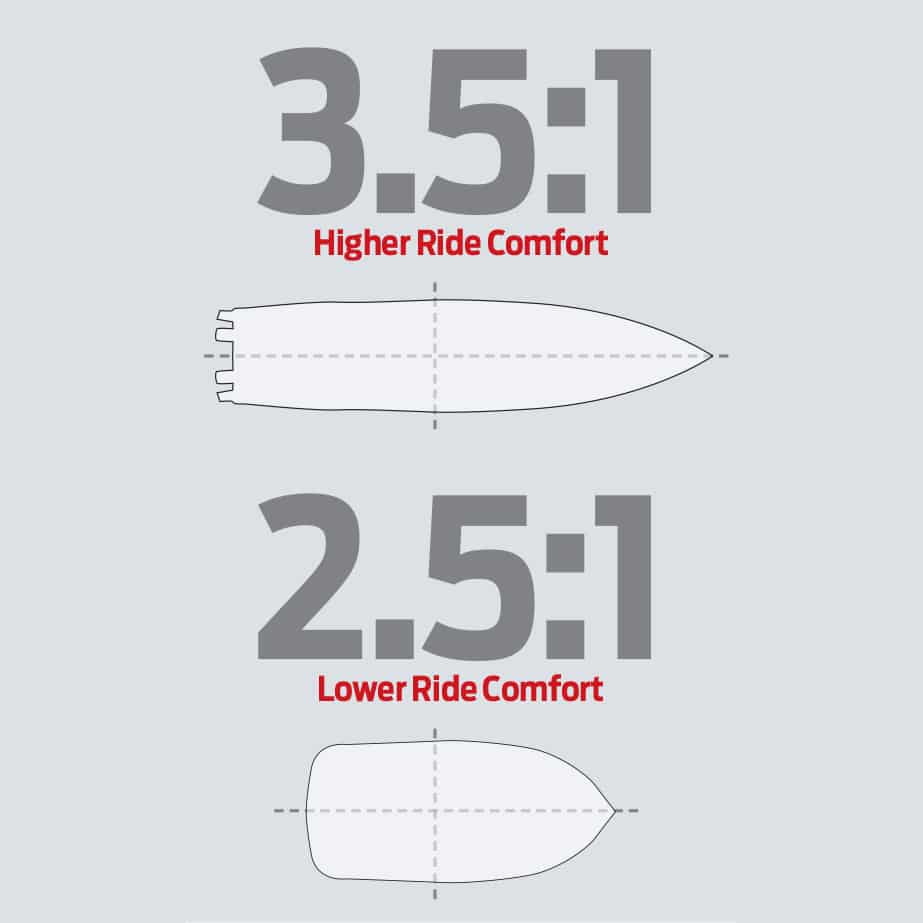
Peters also advised inquiring about a preferred design’s origins. Was it designed in-house at the boatbuilding facility? Was it designed by a naval architect? What are his or her credentials?
“Some people might not care, but it will help you better understand the design,” he said. “With a car, we accept that all the engineering is done correctly, and we can choose our favorite based on appeal alone. With a boat, you should think about engineering and stability calculations, not just styling.”
Finally, Peters noted that good hull designs stand the test of time. With most major advancements taking place in hybrids, like stepped hulls and multihulls, the average boat owner is going to be looking at hull designs that haven’t changed much in 20 or 30 years. And that’s OK.
“Most people just want a good family boat,” he said. “I’d say stay in the middle. The hull should look familiar. That hull from 30 years ago is still a good hull.”
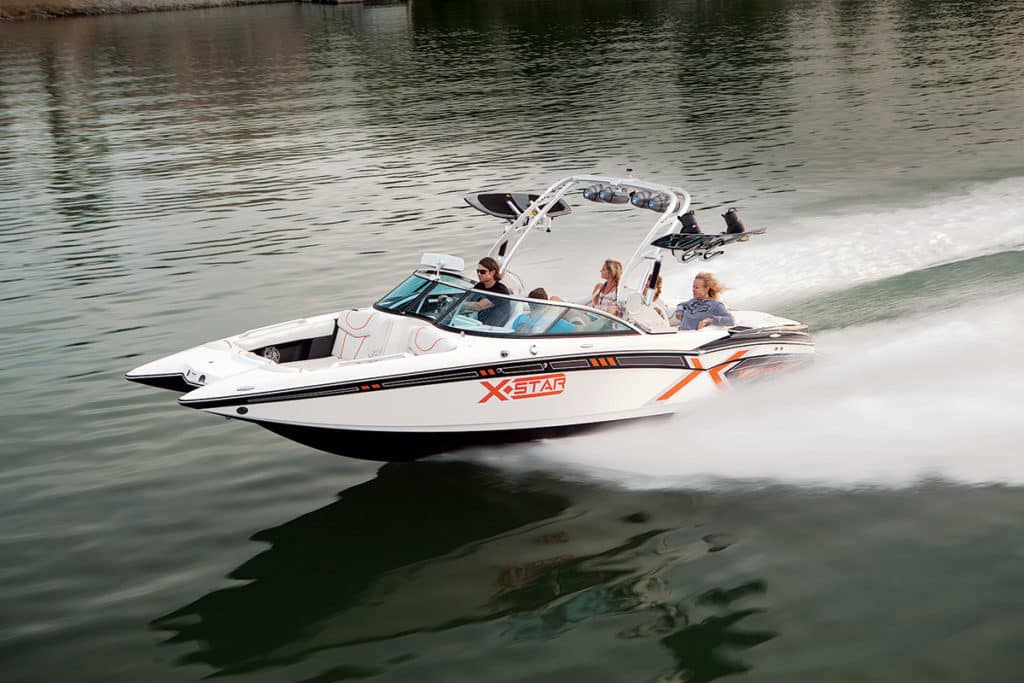
A Boat’s Soft Ride is Subjective
Peter Granata, owner of Palmetto Bluff, South Carolina-based Granata Design , has been designing boats since the early 1970s. With a number of award-winning designs and patented ideas under his belt, he’s firm in his conviction that the soft-ride discussion really shouldn’t be about the boat. It’s about the people involved.
“First of all, the hull ride is felt rather than measured,” he said. “And, it’s based very much on your own individual perception of what the boat looks like and what you expect it to deliver, plus your experience up to that point. It’s very subjective.”
Soft can be a relative term. A boater who is downsizing from a 60-foot yacht to a 30-foot pocket cruiser might find the smaller boat has the worst ride he’s experienced to date, whereas a boater jumping up from a 16-footer will say that 30-footer provides the best ride he’s ever had.
The most important questions a boater can ask, Granata said, are: How well does this design meet its intended purpose, and what can it do for me?
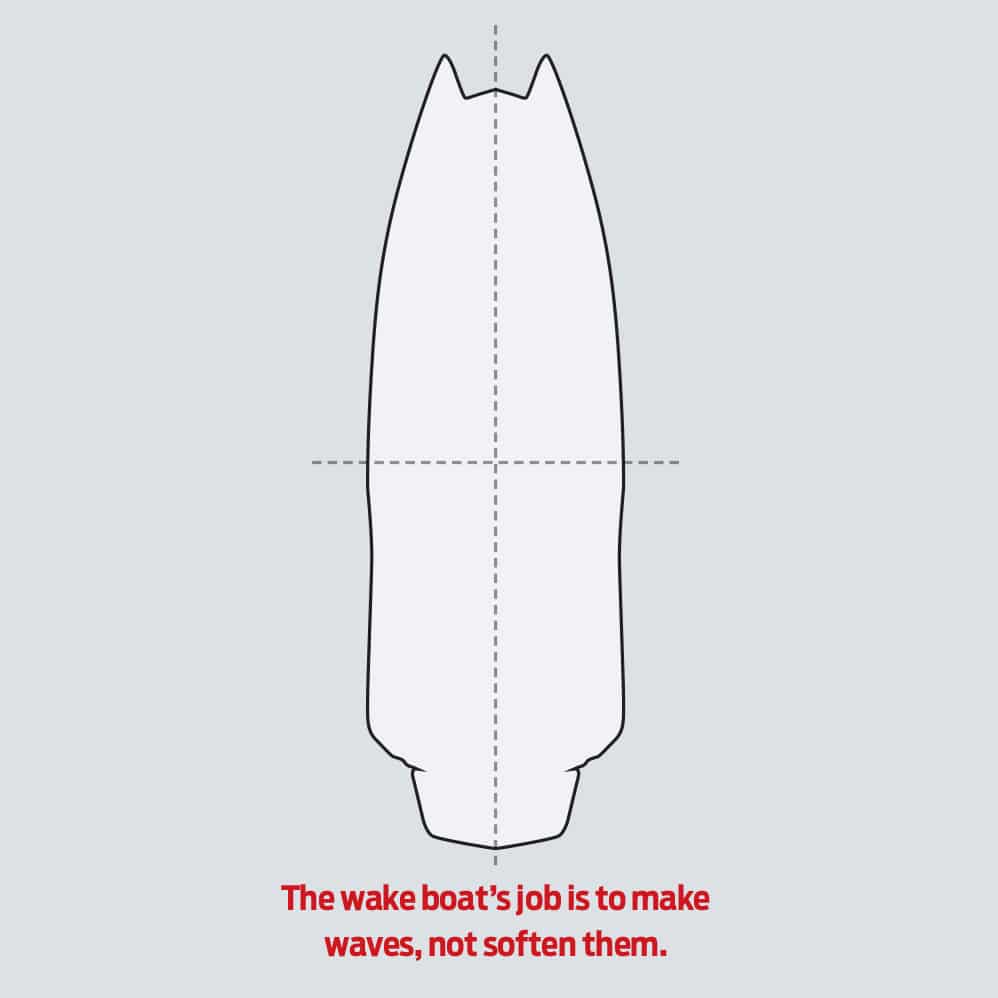
He provided a wakeboard boat as an example. The expectation is for thrills, not the softness of the ride.
“Soft ride is certainly a measurement when it comes to boat design, but it’s not the only one,” he said. “A designer should manage the ride aspect to meet the customer’s expectation. Does the boat do what it’s intended to do?”
The idea is that ride is less important than function, based on customer priorities. If you’re headed offshore and a dry ride is your No. 1 priority, you’ll want to make sure the hull has enough flare to ensure that the water follows the hull and travels outboard rather than over the deck. If you’re an angler, you might look for hull cutaways in the right spots to support the design’s self-bailing characteristics. Bass anglers seek extra buoyancy forward to support their weight.
With “dockominiums,” deep deadrise is unnecessary because owners place a higher priority on stability at rest, accommodations and space for entertaining. And with water-sports boats, the wake is all-important. Without that, the hull is worthless.
“We get so wrapped up in the specifics of hull generation that we forget someone has to buy it and spend time in it,” Granata said. “A designer has to know how the boat will be used, and you do as well. The boat is for you, not for the guy who made it.”
- More: boat building , Boats , Center Consoles
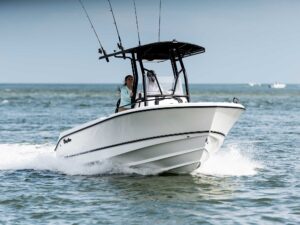
Boat Test: 2024 EdgeWater 208CC Watchman
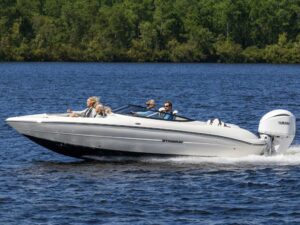
Boat Test: 2024 Stingray 23 OSX
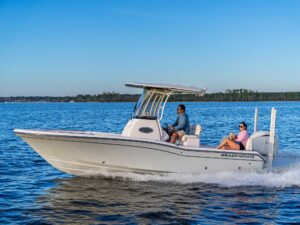
Boat Test: 2024 Grady-White 231 Coastal Explorer
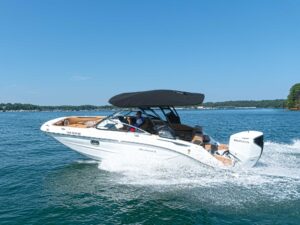
Boat Test: 2024 Hurricane SunDeck 2600 OB
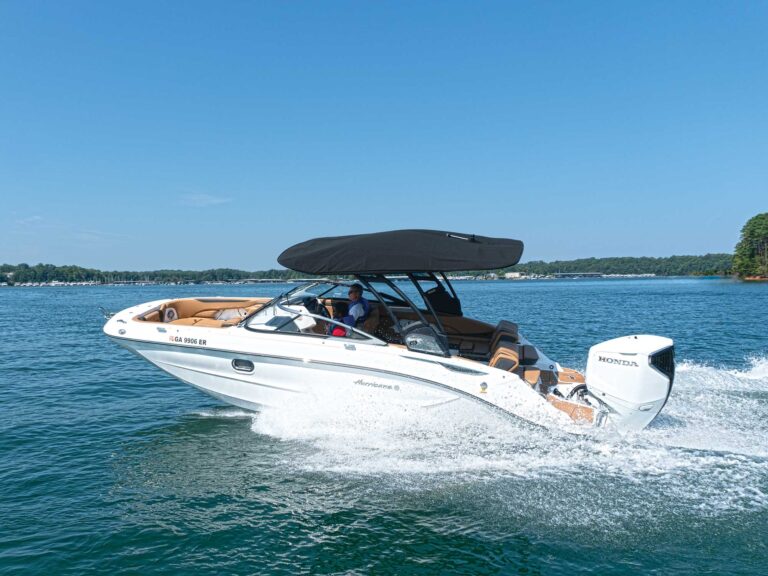
Boat Test: 2024 Brabus Shadow 1200 Sun-Top
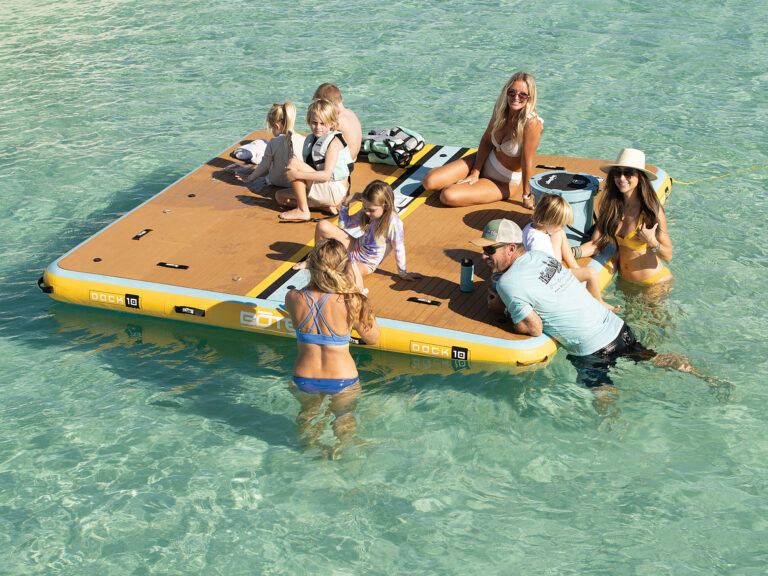
Inflatable Water Mats for Boaters
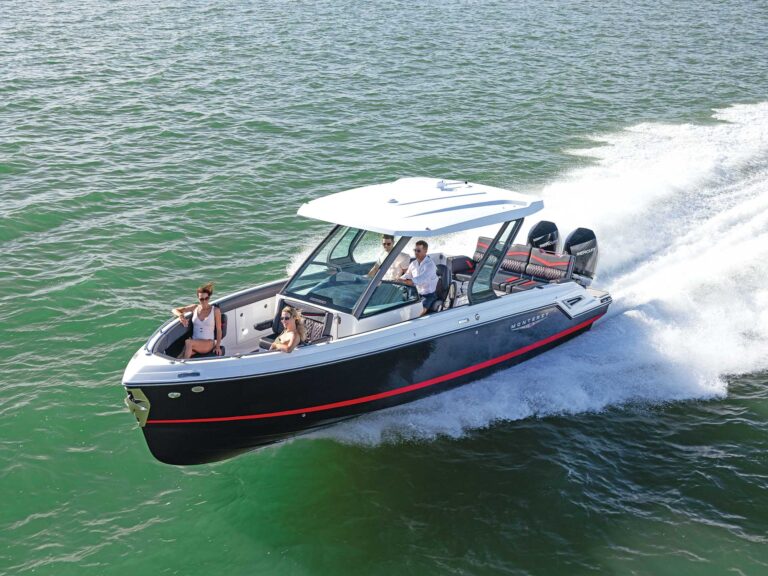
Boat Test: 2024 Monterey Elite 30

- Digital Edition
- Customer Service
- Privacy Policy
- Terms of Use
- Cruising World
- Sailing World
- Salt Water Sportsman
- Sport Fishing
- Wakeboarding
Many products featured on this site were editorially chosen. Boating may receive financial compensation for products purchased through this site.
Copyright © 2024 Boating Firecrown . All rights reserved. Reproduction in whole or in part without permission is prohibited.
672 Wine Club
- Motorcycles
- Car of the Month
- Destinations
- Men’s Fashion
- Watch Collector
- Art & Collectibles
- Vacation Homes
- Celebrity Homes
- New Construction
- Home Design
- Electronics
- Fine Dining
- Benchmark Wines
- Brian Fox Art
- Disneyland Resort
- Ka La’I Wakiki Beach
- Kalamazoo Grill
- Raffles Hotels & Resorts
- Sports & Leisure
- Health & Wellness
- Best of the Best
- The Ultimate Gift Guide
The 10 Best Explorer Yachts for High-Seas Adventures
A 350-foot gigayacht or 60-foot cruiser size isn't what defines an explorer yacht. the devil's in the details when it comes to authenticity., julia zaltzman, julia zaltzman's most recent stories.
- These Charter Yachts Let You Tag Hammerhead Sharks and Count Spirit Bears for Research
- These Luxe Villas Are the Place to Stay in This Retro-Chic Enclave on the Tuscan Coast
- The 7 Most Exciting New Superyacht Marinas in the World
- Share This Article

Unlike fashion trends that seem to move as fast as a Redbull F1 car, the yachting industry takes its time adopting new ideas. There seems to be one exception. Explorer vessels, born out of the owners’ desires to go farther and stay longer, without sacrificing creature comforts, is developing with some urgency.
Several dozen builders and designers are now focusing on explorers, but they are also consulting with adventure travel firms that have a long history of using expedition yachts in remote parts of the globe. ICON Yachts, for example, collaborated with Cookson Adventures and the International Seakeepers Society on its Project Mission in both the overarching design and the details found across the yacht. Adventure outfitter EYOS employs its expertise routinely with Damen’s explorer vessels, most recently with the 190-foot Pink Shadow. EYOS has a list of 50 features that separate authentic explorers from faux versions that might look the part but lack the necessary infrastructure and design elements.
Long-range cruising, system redundancy for autonomy at sea, and storage to carry specialist equipment like submersibles are some of the requirements that define expedition boats. There’s also deck configuration for the easy launch of tenders and toys, along with strong, ice-class hulls and climate-controlled areas comfort in extreme polar and tropic regions.
We culled through the latest fleet of explorers with multiple lengths and designs, selecting a single feature that we think makes it best in class. Here are 10 of our favorites.
Best Pilothouse: Doggersbank 77 Offshore

More than 700 Doggersbank motoryachts have been built since the 1960s, with the latest model scheduled for delivery in 2025. The robust, offshore vessels are designed by Dutch studio Vripack for long ocean passages, assisted by a high, flared bow. “It prevents green water from hitting the wheelhouse windows in rough seas, and together with the Portuguese bridge, ensures the captain’s view is not obstructed,” Joost Mertens, Doggersbank fleet manager, told Robb Report . “The yacht’s steel hull ensures the yacht sits better in the water making it less vulnerable to wind and high waves.”
Best Deck Configuration: Columbus Crossover 42

The Columbus Crossover 42 is defined by both straight and angled surfaces, tapered stern sections and a concentration of volume in the bow that is becoming on many explorers. What is atypical is the yacht’s compact but flexible dimensions that accommodate a large cockpit tender and a 108-square-foot swimming pool with relaxation areas. Sold to an U.S. customer, it’s scheduled for delivery in 2025.
Best Multipurpose Stern: Bering B165

Turkish boatbuilder Bering Yachts revealed details of its new 162-foot flagship explorer yacht, the B165 , at the Dubai International Boat Show in March. The yacht can carry 18,400 gallons of fuel, which the builder says will give it a 4,000 nautical mile range when cruising at 12 knots. It also has a 2,640-gallon holding tank. What singles the B165 out among other explorers, however, is its multi-purpose stern area for both function and form. The elongated aft deck has a swimming pool surrounded by sunbeds. When the bulwarks are folded down, the space becomes an even larger overwater terrace. When the pool is not in use, it can be used as a covered storage area for water toys and expedition equipment. The yacht’s two tenders are also stored on the aft, making it a flexible space for both equipment and guests.
Best Family-Friendly Concept: Project Mimer

This 197-foot expedition concept by Tillberg Design of Sweden caters to family travel with a helicopter pad as well as multiple tenders and toys. It’s pitched by the studio as an introduction to true explorer yachting. It has a functional crew layout for efficient operations and an upper deck owner’s suite with a forward terrace and spa pool. With a hull that will be built to the Polar Code Category, the concept also has an optional helipad aft and long list of toys, from an electric luxury tender and two expedition RIBS to quad bikes, a submersible, Jet Skis, and, of course, an amphibious vehicle. The five-decked yacht sleeps 12 guests with crew quarters for 17 and an additional staff member, such as a nanny.
Best Ice Explorer: Damen SeaXplorer 105

Damen’s 345-foot SeaXplorer 105 is the largest model in the SeaXplorer range, with exterior design by Azure Yacht Design. The platform was developed under the guidance of expedition specialists EYOS Expeditions, who considered over 150 design criteria, from the hull form and bridge layout to the tender davits and Zodiac boarding arrangements. But it is EYOS’s expertise in the polar regions—it facilitated the first heli-ski charter in Antarctica and the first 3,200-foot sub dive to the Antarctic midnight zone—that gives the vessel its point of difference. The SeaXplorer has an ice-strengthened hull and a specially shaped icebreaking stern to maneuver through rough terrain.
Best Interior: Project Fox

On top of having a cool name, Project Fox has a bright, contemporary interior, courtesy of London’s Q Design, that is becoming more common on expedition yachts. The full-beam owner’s stateroom is also one of the yacht’s standout features, with its marble en suite and hardwood floors. The salon is also luxe, with white walls that brighten up travel even in areas that are sunlight deprived. Project Fox also has four other staterooms.
Best Autonomy: Project Master

ICON Yachts’s Project Master was a transoceanic offshore support vessel before the Dutch shipyard began a refit to turn it into an explorer yacht (see before and after inset). It’s equipped with diesel-electric hybrid propulsion, a wide beam for multiple tender spaces, a 7,200-nautical mile range, and flexible cabin arrangements for expedition crew. Other features include a science lab and a certified heli-deck. “The yacht’s helicopter and sub capability mean it can offer assistance in areas with challenging access and little infrastructure,” Micca Ferrero, owner of ICON Yachts, told Robb Report . “The design is for the demands of self-sufficient voyages.”
Best Use of Volume: Arcadia Yachts A96

The A96 mixes the lines, volume, and open-plan layout of Arcadia’s Sherpa series with the speed, joystick maneuverability, and quality of the yard’s A range. It’s the first Arcadia to have an Igor Lobanov-designed interior, as well as a high bow and high deckheads for traversing rough water. But its big differentiator is the 214 gross tonnes of volume and 24-foot beam that generate big volumes—4,300 square feet of usable space, which is 30 percent more than on other similar-sized yachts. Low bulwarks and lateral walkways emphasize the sense of openness.
Best Bow: Project Shackleton

This 351-foot build from Lürssen has an inverted bow that looks like an eagle’s beak. The shape is designed to slice through waves with much lower vibration through the hull, while also reducing rock and roll in rough seas. Unlike the quasi-research vessel exteriors of many explorers, this vessel is representative of the changing look of many in this growing segment.
Best Multi-Mode Hull: Azimut Magellano 60

The Magellano 60 isn’t technically an explorer yacht. Think of it as a cruiser designed for some long-distance travel. But it does have one very interesting feature, what its builder Azimut calls a “dual-mode” hull. The semi-planing shape is designed to optimize fuel consumption (and therefore lower emissions) by about 20 percent (compared to similar-sized vessels) at low and medium speeds. The yacht’s bow is also designed to cut through waves for better seakeeping at a range of speeds. The boat cruises very efficiently at 18 knots but will hit a top end of 26, thus delivering the performance of a planing hull with the benefits of a displacement hull.
Read More On:
- Expedition Yachts
- Explorer Yachts
More Marine

Meet Spitfire, a New 164-Foot Superyacht Based on a High-Performance Patrol Boat

What It’s Like to Watch an America’s Cup Race Right From the Water

Austin Parker Unveils Not One but 6 New Yachts at Cannes Fest

This New 72-Foot Yacht’s New Hybrid Propulsion System Is the First of Its Kind

Meet the Wine Club That Thinks Differently.
Receive editor-curated reds from boutique California producers four times a year.
Give the Gift of Luxury
Latest Galleries in Marine

Spitfire Superyacht in Photos

The AX/E 22 and AX/E 25 in Photos
More from our brands, mary mcfadden dies at 85, nba strikes airbus deal for 13 planes, delta to operate flights, cannes winner ‘all we imagine as light’ at center of oscar entry battle between france and india (exclusive), new york supreme court throws out lawsuit accusing helen frankenthaler foundation of exploiting the late artist’s legacy, the best yoga mats for any practice, according to instructors.
The Challenges of Sailing in Rough Seas: Tips and Strategies
Discover how to safely navigate through rough seas and overcome the challenges that come with sailing in unpredictable weather conditions.
Sailing in rough seas can be a daunting and challenging experience, even for the most seasoned sailors. The unpredictability of the ocean, combined with the potential for dangerous weather conditions, can make for a nerve-wracking journey. However, with the right preparation, knowledge, and mindset, you can overcome these challenges and safely navigate your way through rough waters. In this article, we will discuss some of the most common challenges faced by sailors in rough seas, as well as tips and strategies for overcoming them.
Understanding the Dangers of Rough Seas
Before we delve into specific tips and strategies, it’s important to understand the potential dangers that rough seas can present. Some of the most common hazards include:
- Large waves and swells, which can cause your boat to pitch and roll violently
- Strong winds, which can make it difficult to maintain control of your vessel
- Reduced visibility due to rain, fog, or spray from breaking waves
- Rapidly changing weather conditions, which can catch you off guard if you’re not prepared
- The risk of collision with other vessels, debris, or even land if you’re sailing close to shore
By being aware of these potential dangers, you can take steps to mitigate them and ensure the safety of your crew and vessel.
Preparing Your Boat for Rough Seas
One of the most important aspects of sailing in rough seas is ensuring that your boat is properly prepared for the conditions. Here are some tips for getting your vessel ready for a challenging journey:
1. Inspect and Maintain Your Rigging
Before setting sail, it’s crucial to thoroughly inspect your rigging and ensure that everything is in good working order. Check for any signs of wear or damage, such as frayed lines, corroded fittings, or cracked turnbuckles. Replace or repair any damaged components as needed, and make sure that all lines are properly tensioned.
2. Secure Loose Items
In rough seas, loose items can quickly become dangerous projectiles. Take the time to secure any loose gear, both on deck and below. This includes stowing away items like tools, dishes, and personal belongings, as well as securing larger items like dinghies, life rafts, and spare anchors.
3. Check Your Bilge Pumps and Through-Hulls
Make sure that your bilge pumps are functioning properly and that your through-hull fittings are in good condition. In rough seas, water ingress can be a major concern, so it’s important to ensure that your boat is watertight and able to effectively pump out any water that does make its way on board.
4. Prepare Your Crew
Ensure that your crew is well-rested, well-fed, and properly outfitted with appropriate foul weather gear. Discuss your plans and expectations for the journey, and make sure that everyone is familiar with their roles and responsibilities in rough conditions.
Strategies for Sailing in Rough Seas
Once your boat is properly prepared, it’s time to set sail. Here are some strategies for navigating rough seas safely and effectively:
1. Choose the Right Course and Speed
When sailing in rough seas, it’s important to choose a course and speed that will minimize the impact of the waves on your boat. This may involve altering your intended route or slowing down to reduce the risk of damage or injury. In general, it’s best to avoid sailing directly into or away from large waves, as this can cause your boat to pitch and roll excessively. Instead, try to maintain a course that allows you to ride the waves at an angle, which can help to smooth out the motion of your boat.
2. Use Your Sails Wisely
In strong winds and rough seas, it’s important to strike a balance between maintaining control of your boat and reducing the strain on your rigging. This may involve reefing your sails to reduce their surface area, or even switching to a smaller headsail or storm jib if conditions warrant it. Be prepared to make adjustments to your sail plan as conditions change, and always prioritize the safety of your crew and vessel over maintaining a fast pace.
3. Monitor the Weather
Keeping a close eye on the weather is crucial when sailing in rough seas. Make use of available weather forecasts and satellite imagery, and be prepared to adjust your plans if conditions deteriorate. If you’re caught in a storm, try to maintain a course that keeps you in the storm’s “navigable semicircle,” which is the area where the winds and seas are generally less severe.
4. Practice Good Seamanship
In rough seas, good seamanship is more important than ever. This includes maintaining a proper lookout, communicating effectively with your crew, and making smart decisions based on the conditions and capabilities of your boat. Remember that it’s always better to err on the side of caution and take a conservative approach to sailing in rough conditions.
Overcoming Fear and Anxiety
For many sailors, one of the biggest challenges of sailing in rough seas is overcoming the fear and anxiety that can accompany such conditions. Here are some tips for managing these emotions and maintaining a positive mindset:
1. Trust Your Boat
Remind yourself that your boat is designed to handle rough seas, and that it’s capable of keeping you safe as long as you take the proper precautions. Focus on the steps you’ve taken to prepare your boat for the conditions, and trust in its ability to carry you through.
2. Focus on the Task at Hand
When conditions are challenging, it’s important to stay focused on the task at hand and avoid becoming overwhelmed by the situation. Break tasks down into smaller, manageable steps, and concentrate on completing each one to the best of your ability.
3. Breathe and Stay Calm
In stressful situations, it’s easy to forget to breathe deeply and maintain a sense of calm. Practice taking slow, deep breaths, and remind yourself that you are capable of handling the challenges that lie ahead.
4. Learn from Your Experiences
Each time you sail in rough seas, you’ll gain valuable experience and knowledge that will help you become a more confident and capable sailor. Embrace these challenges as opportunities for growth, and remember that with each successful journey, you’re becoming better equipped to handle whatever the ocean throws your way.
Sailing in rough seas can be a challenging and intimidating experience, but with the right preparation, knowledge, and mindset, it’s possible to overcome these obstacles and safely navigate your way through even the most difficult conditions. By understanding the potential dangers, preparing your boat and crew, and employing smart sailing strategies, you can confidently face the challenges of rough seas and continue on your journey of exploration and adventure.
- Sailing Heavy Weather: Yacht vs. Catamaran - Choosing the Right Vessel for Rough Seas
When it comes to sailing, one of the most exhilarating experiences is navigating through heavy weather. The clash of wind and waves, the challenge of maintaining control, and the thrill of conquering the elements make it an adventure like no other. However, choosing the right vessel can significantly impact your safety and comfort during such conditions. In this comprehensive guide, we will explore the differences between yachts and catamarans when it comes to sailing in heavy weather. Whether you're a seasoned sailor or a novice, understanding the advantages and disadvantages of each vessel will help you make an informed decision.
Yacht vs. Catamaran: The Basics
Yachts are known for their elegance and traditional design. They are single-hulled vessels with a deep keel that provides stability in calm waters. However, when it comes to heavy weather, yachts have some limitations:
- Less Stability : Yachts have a narrower beam, which makes them less stable in rough seas.
- Heeling : Yachts tend to heel or lean to one side in strong winds, making them more challenging to control.
- Slower Speed : Yachts are generally slower than catamarans, which can be a disadvantage when trying to outrun a storm.
Catamarans, on the other hand, have gained popularity for their unique design and superior performance in various conditions. Key advantages of catamarans in heavy weather include:
- Stability : Catamarans have a wider beam, which provides excellent stability, reducing the risk of capsizing.
- Reduced Heeling : Catamarans remain level even in strong winds, offering a more comfortable sailing experience.
- Speed : Catamarans are faster due to their twin-hull design, allowing you to navigate heavy weather more efficiently.
Sailing a Catamaran in Heavy Weather
If you've chosen a catamaran for your heavy-weather adventures, it's essential to understand some essential tips and techniques:
1. Reef Early
When you see dark clouds or feel the wind picking up, reef your sails early. Reduce the sail area to maintain control and prevent capsizing.
2. Keep a Close Eye on the Weather
Stay updated with weather forecasts. Modern technology and apps make it easier than ever to monitor changing conditions while at sea.
3. Maintain Speed
Catamarans thrive on speed. Keep moving forward to maintain control. Avoid pointing directly into the wind, as this can lead to a capsize.
4. Balance the Load
Distribute weight evenly to ensure the catamaran remains balanced. This is crucial for stability during heavy weather.
5. Practice Seamanship
Learn and practice seamanship skills, including handling waves, steering techniques, and emergency procedures.
Catamaran for Sale: Finding the Right One
If you're considering purchasing a catamaran for heavy-weather sailing, you'll find various options on the market. Here are some tips for finding the perfect vessel:
1. Budget-Friendly Options
Explore catamarans for sale in the Caribbean if you're looking for affordable options. The region offers a wide range of choices at competitive prices.
2. Performance Matters
Consider a performance catamaran for sale if you plan to sail in challenging conditions frequently. These vessels are designed for superior speed and stability.
3. Size Matters
Choose a catamaran size that suits your needs. Smaller models are more manageable for solo sailors, while larger ones offer more space for crew and equipment.
Heavy Weather Sailing: Yachts vs. Catamarans
Now that we've covered the basics let's delve deeper into the comparison between yachts and catamarans in heavy weather sailing.
Yachts in Heavy Weather
1. hull design.
Yachts typically have a monohull design with a single, deep keel. While this design provides stability in calm waters, it can be a disadvantage in heavy weather. Yachts are prone to heeling, where they lean to one side in strong winds. This heeling can be uncomfortable for passengers and challenging for the crew to manage.
2. Capsizing Risk
Due to their single-hull design, yachts have a higher risk of capsizing in heavy weather. When hit by a strong gust of wind, a heeling yacht can reach a critical angle of heel, leading to a potential capsize. This risk necessitates vigilant seamanship and early reefing of sails when sailing a yacht in heavy conditions.

3. Speed and Maneuverability
Yachts are generally slower than catamarans, which can be a disadvantage when trying to outrun or navigate through a storm. Their deeper keel design may limit their ability to sail in shallower waters, reducing their maneuverability.
Read our top notch articles on topics such as sailing, sailing tips and destinations in our Magazine .
Check out our latest sailing content:
Catamarans in heavy weather, 1. stability.
Catamarans are known for their stability in heavy weather. Their twin-hull design provides a wider beam, making them less prone to heeling. This stability offers a more comfortable and secure experience for passengers.
2. Reduced Heeling
Unlike yachts, catamarans remain level even in strong winds. This reduced heeling minimizes the risk of items falling and passengers feeling seasick. It also makes it easier for the crew to maintain control of the vessel.
3. Speed and Efficiency
Catamarans excel in heavy weather due to their speed and efficiency. Their twin-hull design allows them to slice through rough seas with less resistance. This speed can be crucial when trying to outrun or navigate through storms, improving safety and comfort.
Sailing a Catamaran in Heavy Weather: Advanced Techniques
As you gain experience in heavy weather sailing with a catamaran, you can explore advanced techniques to enhance your skills and safety:
6. Use Storm Sails
Invest in storm sails specifically designed for heavy weather conditions. These smaller, more robust sails are easier to control and maintain stability.
7. Master Reefing
Perfect the art of reefing your sails quickly and efficiently. Proper reefing is crucial for maintaining control and preventing over-pressuring the rigging.
8. Learn Heavy Weather Navigation
Study advanced navigation techniques for heavy weather conditions. This includes understanding wave patterns, currents, and strategies for avoiding dangerous areas.
9. Emergency Procedures
Familiarize yourself with emergency procedures such as man overboard drills, deploying sea anchors, and abandoning ship protocols. Being prepared for the worst-case scenario is essential for safe heavy weather sailing.
Catamaran for Sale: What to Look For
When searching for the ideal catamaran for heavy weather adventures, consider these additional factors:
4. Seaworthiness
Ensure the catamaran you choose is designed for seaworthiness. Look for features such as reinforced hulls, robust rigging, and watertight compartments for added safety.
5. Accommodation
Consider the number of cabins and the layout of the catamaran. Adequate accommodation is essential for comfort during extended heavy weather voyages.
6. Equipment and Safety Features
Check for essential equipment such as life rafts, EPIRBs (Emergency Position-Indicating Radio Beacons), and other safety features. These can be lifesavers in case of emergencies.
Sailing in heavy weather can be both a challenge and an adventure. Your choice between a yacht and a catamaran significantly impacts your experience. While yachts offer elegance and tradition, catamarans provide stability and speed, making them a popular choice for adventurous sailors. Remember to practice safe seamanship, stay informed about weather conditions, and continually improve your skills to ensure a successful voyage.
So what are you waiting for? Take a look at our range of charter boats and head to some of our favourite sailing destinations.
I am ready to help you with booking a boat for your dream vacation. Contact me.

Denisa Kliner Nguyenová
- 2024 BOAT BUYERS GUIDE
- SWS ADVENTURES
- Email Newsletters
- Fishing Boat Reviews
- Fly Fishing
- Marine Electronics
- Fishing Tackle
- Fishing Destinations
- The Bahamas Fishing Guide
- Boating Safety
- Ultimate Boat Giveaway

Boating Tips for Rough Seas
- By Capt. Dave Lear
- Updated: August 22, 2022
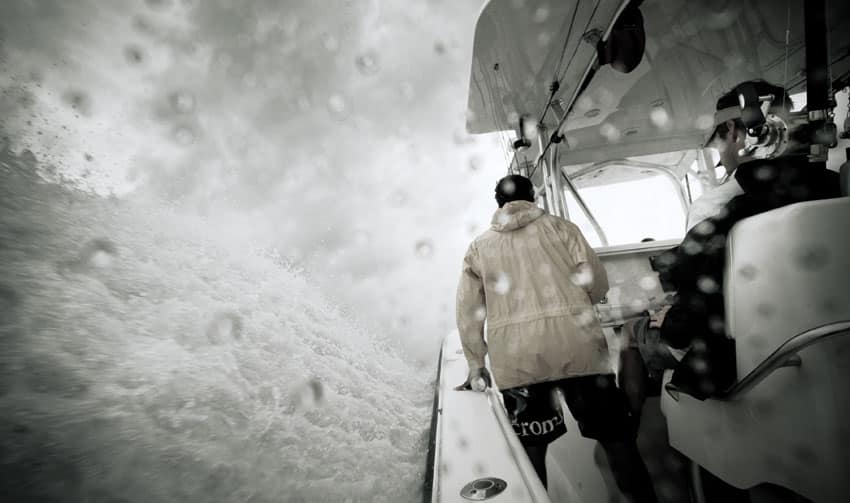
Unless you’ve got 50-plus feet of fiberglass underneath you, you’re not immune to stormy weather conditions. Run offshore this time of year and sooner or later you’re going to get caught in high winds, big seas or both. Large sport-fishing boats in rough seas have the length and beam to handle the slop. But small to mid-size vessels are at greater mercy. If you slow down and drive accordingly, potentially hazardous situations can be avoided for small boats in rough seas.
“In the summertime, sooner or later you’re going to have a big line of thunderstorms, 40-knot winds and 6- to 8-foot seas between you and the dock,” explains Marcus Kennedy, a tournament competitor on the Yamaha professional tour. “Novice boaters in rough water don’t realize that and they panic and don’t know what to do. But all it takes is common sense to drive a boat in rough water. If you tack like a sailboat with quartering waves off the bow or stern, you’ll have a better ride and make better time. Safety is always paramount.”
Kennedy, who fishes a Yellowfin 36 center console from Dauphin Island, Alabama, often makes long runs to find fish in adverse seas. During a recent out-of-town king mackerel event, he ran 100 miles down Florida’s Gulf Coast to take advantage of calmer nearshore water before angling out to the Dry Tortugas. The final southwest track let him run in a favorable trough.
How to Drive a Boat in Rough Water
“You want to plan your route to optimize the boat’s running angle with the sea conditions,” Kennedy says. “Avoid a dead-head or beam sea whenever you can because it’s nearly impossible to make any headway. During tournaments we partner with another boat and stay in sight or radio contact in case of emergencies. And you should always carry twice as much fuel as you think you’ll need. Boats in rough water and seas gulp the gas.”
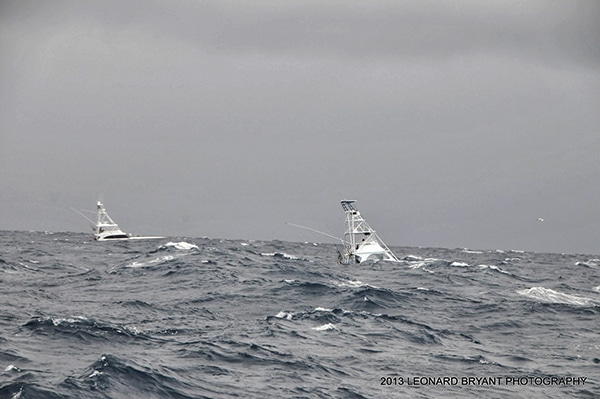
Capt. Frank Crescitelli, a New York charter captain and tournament contestant, faces similar conditions off the Atlantic seaboard during the summer months. A run from New Jersey’s Long Beach Island to the Hudson Canyon is 96 miles. Heading south to the Baltimore Canyon is a 92-mile leg, and Crescitelli often targets bluefin tuna out to 40 miles. And he recognizes the best path back to port is not always the one he took offshore.
“I never head out if I know I’ll have two rough rides,” he says. “Our prevailing summer wind is southwest and I can deal with that one way. But I always plan on the possibility of deviating from my course if necessary. I’d rather zigzag or return to a different port if it means a smoother, safer ride.” Crescitelli runs a Regulator 32 center-console for his offshore charters, and radar is an essential part of its onboard equipment.
“I check the forecast beforehand and constantly monitor the radar and Sirius weather during the day,” he says. “I avoid storms whenever possible. My radar has a 50-mile range, so that gives me plenty of time to react. But I always know the compass heading home in case we lose electronics or have electrical interference.
“One of the biggest mistakes people make is running directly for the dock whenever a storm blows up,” Crescitelli adds. “But sometimes it’s better just to ride it out. Most of these summer storms are fast moving, so if you make slow forward headway keeping the bow into the wind, it’ll often blow right by. Otherwise, it could follow you the whole way home and make for a long, miserable ride.”
Knowing your boat’s performance characteristics is also important in how to drive your boat in rough water, says Capt. Dan Stauffer, who runs charters out of Ocean City, Maryland, aboard a classic 31-foot Bertram with twin diesel engines. Stauffer says his hull handles predictably in rough seas yet is also relatively light for its size. He added 1,000 pounds of lead ballast to help keep the bow from porpoising.
“Two years ago we got caught in honest 10-footers,” he said. “I was standing on the bridge looking eye level at the waves. I’ve also been sandwiched between two storms when the straight-line winds were so strong it stalled the radar. But that doesn’t happen often, maybe only a dozen times a year out of 120 trips. If I can’t get around something, my first reaction is turn into the wind, slow down and idle until it moves on by.
How to Trim a Boat in Rough Water
“Some guys never even touch the trim tabs and that always makes me scratch my head,” he added. “It’s all about the tabs. If you tab down in a following sea with certain hulls, you can turn it into a submarine. With my boat, however, I add a little to get that bow down in a head sea so it’s chewing the waves. You have to know how your boat performs under different conditions, and tabs are the great equalizer.”
When Crescitelli encounters rough seas, he has his crew stay nestled in beanbags in the cockpit. He also carries a Winslow life raft aboard, and the emergency ditch bag is tied within reach at the leaning post.
“Don’t ever get into panic mode,” he says. “If you do, you’ll make bad decisions. Things have to be really bad to get out of a 32-footer and into an 8-foot life raft. So I’d rather slow down and safely surf the waves home in the boat, even if it takes more time.”
Safety and Boating Tips for Fishing Boats in Rough Seas
- Slow down. Slower speeds allow better reaction time. Adjust the throttle to ascend/descend waves to avoid taking on water.
- Use the trim tabs carefully. Too much down tab can force the bow into oncoming waves, while no tabs allow the hull to plane as designed.
- Keep an eye on the radar or satellite weather. It’s always easier to go around a storm than through one.
- Tack into the waves rather than take them head-on, if possible.
- Alter your course to take advantage of more favorable sea conditions.
- Carry plenty of fuel.
- Know the tides and locations of shoals before running an inlet.
- Wear a life jacket.
- File a float plan.
- More: Boating Skills , Boats , Center Consoles , How-To

Scout 357 LXF

Electric Outboard Steering

Best Dredge Fishing Tips for Center Consoles

EdgeWater 208CC Watchman

Spotlight on Quantum
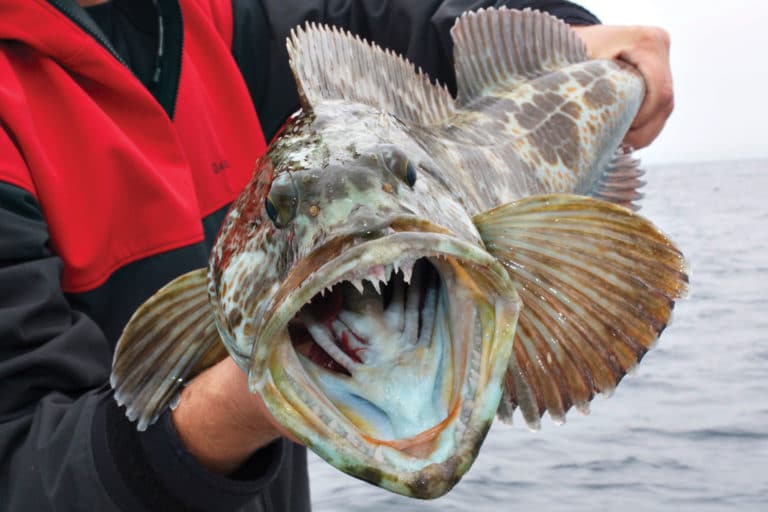
Fishing for Lingcod with Large Saltwater Swimbaits

ODYSSEY Battery: Ask the Internet
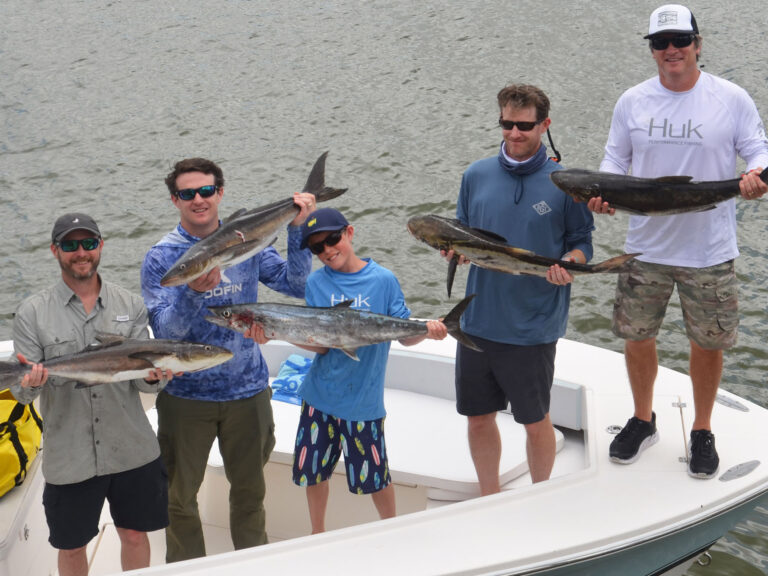
More Restrictive Cobia Regs Expected for Virginia

- Digital Edition
- Customer Service
- Privacy Policy
- Terms of Use
- Cruising World
- Sailing World
- Salt Water Sportsman
- Sport Fishing
- Wakeboarding
- First Name *
- Last Name *
- Boating State * Choose a State Outside US / Canada Alabama Alaska Alberta Arizona Arkansas California - North California - South Colorado Connecticut Delaware District Of Columbia Florida - East Coast Florida - West Coast Georgia Hawaii Idaho Illinois Indiana Iowa Kansas Kentucky Louisiana Maine Manitoba Maryland Massachusetts - North of Boston Massachusetts - Boston and South Michigan Minnesota Mississippi Missouri Montana Nebraska Nevada New Brunswick New Hampshire New Jersey - North of Sandy Hook New Jersey - South of Sandy Hook New Mexico New York - Great Lakes New York - Coastal North Carolina North Dakota Nova Scotia Ohio Oklahoma Oregon Pennsylvania - East Pennsylvania - West Puerto Rico Rhode Island Saskatchewan South Carolina South Dakota Tennessee Texas Utah Vermont Virgin Islands Virginia Washington West Virginia Wisconsin Wyoming
- Comments This field is for validation purposes and should be left unchanged.
“The Best Rough Water Boats Out There. Period.”
Winn willard, president of ray hunt design, reveals his obsession with hunt yachts’ surfhunter 25..
An industry game-changer and pragmatic boat engineer, Winn Willard was on his first boat at age 5. Today, whether cruising Buzzards Bay on his Hunt Yachts Surfhunter 25 (the original Surfhunter model) or evolving Ray Hunt Design, his passion for the life aquatic remains deep. An accomplished naval architect and yacht designer with a staggering amount of boat designs in his portfolio, Willard has recently returned to his own favorite design — purchasing and captaining a Hunt Surfhunter 25 he named Creola .
“I’ve always wanted one,” Willard says of his new boat. “It’s an early hull we’ve updated over the years, and it’s a real sweetheart. In my opinion it’s the best 25-footer rough water boat out there. Period.”
Why is this design his favorite? It’s anchored in the history of Ray Hunt Designs and Hunt Yachts. Based in New Bedford, Mass., and founded in 1966, the 56-year-old Ray Hunt Designs is a naval architecture firm famous for a high-deadrise hull form known as the Hunt Deep V — helmed by Willard’s prescient vision. The result? A solution for performance, seakindliness, comfort, and safety in rough seas, all of which are readily apparent in the Surfhunter 25.
“Hunt Yachts was created by me and a couple other partners,” Willard further explains. “It was developed and then sold to Hinckley in 2013. We take pride in the boats that carry the Hunt name. They must be the best in terms of rough water performance, because that’s what we are known for. The Hunt boats have more deadrise and aggressive Hunt design. They are, and will continually be, the best rough water boats out there.”
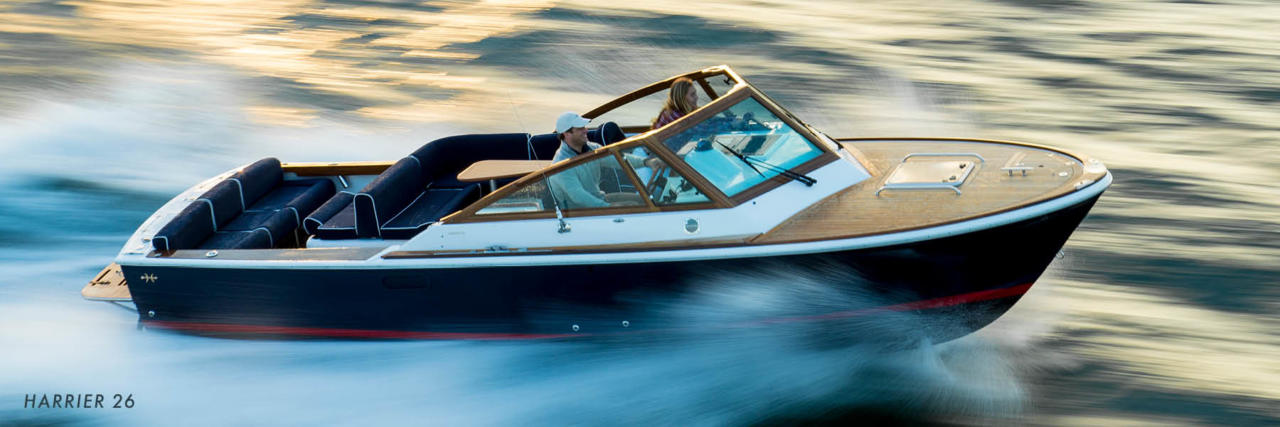
Willard’s penchant for boat building runs in his family. He grew up in Plymouth, Mass., right on the beach. He explains that since the age of 5 he “was always messing around with boats.” A carpenter and boatbuilder, Willard’s Dad built him is first boat — an eight-foot pram. “To keep me occupied, he would start up the little outboard motor, put me in the boat with my life jacket on, and throw out the anchor,” Willard explains. “I could putt-putt around my little boat as far as the anchor line would let me or before I’d run out of gas. My love for the water went from there.”
After attending college at the University of Michigan — one of the few places at the time that offered a degree in naval architecture — Willard went on to business school at Babson College and returned home for a part-time summer job. Back then, Boston was a hub for aspiring boat designers. “I took a roll of drawings under my arm, went to Hunt, and said, ‘Hey, need a draftsman?’” Willard says. “Ray Hunt’s partner hired me on a part-time basis, so I was going to school in the morning and working for him in the afternoon. One thing led to another and it’s essentially the only job I’ve ever had.”
Throughout his career he’s led an incredible amount of boat designs. He’s concepted sailboats, 100-foot motor yachts, even a 10-foot jet ski for Honda. He’s designed for Chris-Craft, Boston Whaler, Regal, Robalo, Cruisers Yachts, Four Winns, and many others. Yet what makes him most tick? “The more interesting boats are the custom yachts — when owners come in and want something special,” he says. “Those have been fun. But we also do commercial and military boats. And those are especially interesting because they have a job to do. In some cases, people’s lives depend on them. We continue to design boats all over the country and they sell themselves. That’s really rewarding.”
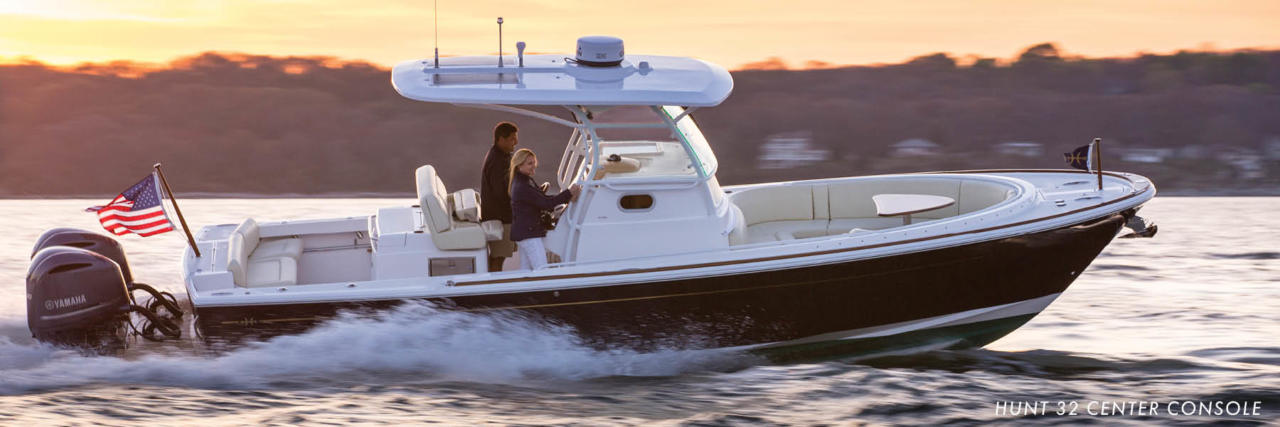
When asked why he thinks Ray Hunt Design is considered a true innovator, he quickly responds with the fact that the V-shape hull was the major pivot. “There was a total paradox shift with Ray Hunt Design,” he explains. “In the 1960s, all motorboats were typically flat bottom boats and had awful handling characteristics. Ray used to demonstrate with his early boats. He would take the boat up to high speed and then take his hands off the wheel and tie his shoelaces. And people would think, ‘Oh my God, don’t let go of the steering wheel!’ But the boat would keep going straight because of its design. It’s a recipe we continue to evolve throughout the years. We update, improve, and adapt to what’s going on in the world. Hinckley Sport Boats and Hunt yachts are more aggressive and a little higher deadrise, with the V shape in the hull, so they will go through the water as smooth as possible.”
Today, you’ll find Willard aboard Creola (named after a Jimmy Buffett son), cruising Buzzard’s Bay with his wife. He also cherishes rides to the Elizabeth Islands. “It’s like you’re in a different world,” Willard says. “There are no lights, no noise. And at the west end of Nantucket, it’s shallow water and you can go to Madaket. The city lights obscure the sky, but when you get out sto those places you realize there are a lot of stars up there. I’m very happy to just sit on my boat and stare at the stars.”
And why, after all these years of boat engineering, did he come back to the Hunt Surfhunter 25? “Being a designer and an engineer, I appreciate boats, cars, and machinery, for what they can do and how they perform. A Hunt boat is by far the best rough water boat. I wouldn’t want to own anything less.”
Click here to learn more about the latest Surfhunter, the Surfhunter 32 , now available with outboard or I/O power.
- boat builder
- boat companies
- boat manufacturers
- center console boats
- cruising yachts
- Hunt Yachts
- luxury motor yacht
- luxury motoryachts
- Uncategorized
- November 2023
- December 2022
- August 2022
- February 2022
- January 2022
- October 2021
- September 2021
- February 2021
- January 2021
- October 2019
- January 2019
- August 2017
- December 2016

10 Tips for Sailing In Heavy Weather

They say that calm seas never made a great sailor. Rough seas and heavy wind are just a right of passage for many. I however would argue that the best sailors are those who manage to avoid heavy weather entirely.
Reading a weather report and planning one’s voyage to avoid nasty weather is the best call of them all. But, if you find yourself under gloomy skies and heavy chop unexpectedly, then getting yourself back to shore becomes paramount.
Here are a few tips for bad weather sailing that have helped salty sailors stay safe.
Table of contents
1. An ounce of prep saves a pound of trouble
Whether it’s replacing the impeller before it goes bad or coiling lines properly before you head out, preparation is the name of the game when it comes to sailboats. They say that the average sailor spends 10 hours working on a boat for every hour sailing and that’s just about how it should be. Making sure everything is working and properly cared for is a full time job and if you're not putting in the hours to keep your boat in tip top condition, your boat will fail you just when you need it most.
Things to watch out for when prepping for bad weather include:
- Scuppers are clean and free flowing. An errant acorn or a wad of tape can turn an otherwise seaworthy boat into a bathtub. Heavy rain and/or crashing waves have been known to sink a vessel that could not properly ship water overboard. Take the time to make sure your scuppers can save your boat and your life in heavy conditions.
- An orderly boat is a safe boat and that includes properly coiling lines. If you don’t know how to properly coil a line then you should learn asap. You never know when you will need to cast off a line or drop a sail in a hurry. Making sure that all your lines are properly coiled ensures that a line will run freely without kinks or “ass holes” when you need it to.
- Engine maintenance is all too often forgotten on sailboats. In heavy weather, bare poles are sometimes much safer than sails and a good working motor can be the difference between life and death. Changing the oil, checking belt tension and visually inspecting through hull fittings should be part of common practice on your boat. Having back up supplies like an impeller, hoses and belts are also part of good maintenance and you should regularly check your supplies and replace them when they get used.
2. Reef early, reef often
If you read last week’s piece on reefing , you may think I am beating a dead horse. But I can’t stress enough the importance of reefing in heavy weather. A better alternative to reefing is using the right sail for the right conditions. Many a genoa jib has been reduced to shreds in heavy air when a skipper fails to change sails in a timely manner.
Much like reefing, which should be done before you actually need to, so too should you raise your storm jib and douse your main before the heavy weather starts. Making the call to reduce sail or go bare poles can be a life saving call when made at the appropriate time. If you don't know how to reef or have difficulty changing sails, you should refrain from sailing in heavy air until you have had a chance to practice in lighter conditions.
3. File a float plan
In this day and age with cell phones and email, we often think help is just a text message away. At sea, especially in heavy air, sending a text message or making a phone call can be impossible.
Rain, wind and waves can kill a cell phone and if you doubt that, here’s a little virtual experience of sailing in heavy weather.
Put on all your foul weather gear, turn your shower on full blast cold and have your partner bring the garden hose into your bathroom. Then stand in the shower while your partner sprays you with the hose. For an even more real experience, crumple up $100 dollar bills and flush them down the toilet while you're at it. Then you will realize that using a cell phone in heavy weather is nearly impossible.
That is where the float plan comes into play. By leaving a detailed account of your planned voyage in writing with someone who cares about you, you will ensure that when you are late someone will miss you. And I can’t stress that you leave your float plan with someone who cares about you enough to miss you if you don’t show back up.
In the marina office where I currently work, one of our guests left a float plan with our staff saying that if they weren’t heard from by June 30th that we should send out a search and rescue mission. I found that note on the peg board in our office on July 22. I never heard if they made it back but didn’t see them on the news either so I am hoping they are safe.
But who knows, they may be stranded in the back of some canyon and 10 years from now we will hear about their amazing survival story.
4. Avoid glass and label your can goods
In rough seas, the galley becomes a battlefield. The pitch and yaw of rough seas and gusty winds can turn a dutch oven into a scud missile. Things like glass jars and wine glasses soon become shrapnel as objects fling themself out of cupboards and smash on bulkheads and cabin floors.
When I was buying my endeavour 42, I hired a delivery captain to fit out the boat and sail it from Tampa Bay to Marathon Florida. As part of his job, he needed to buy living supplies to stay on the boat for three weeks as we brought the boat north to Beaufort, NC.
He bought all sorts of cool things like new pots and pans and a full set of flatware. He also bought a very nice french press coffee pot with a tempered glass cylinder to maximize flavor and keep coffee steaming hot. That coffee pot cost me $50 and lasted barely a mile and half out of port when a wake launched that glass cylinder against the bulkhead. Glass is tough on a sailboat.
That being said, I do love storing dry goods in mason jars afloat. Sure they break often enough, but they are relatively cheap to replace and ensure a watertight seal for your flour, rice, beans, oats and other dry goods that go bad in salty places in plastic bags.
You can protect them in the cupboard with silicone webbing available at most big box stores and online megamarts. But who is really gonna indict Grandma’s go to for preserving peaches when all it costs you a $1 worth of oats when it crashes to the deck.
Another good alternative for heavy weather life aboard ship is can goods. They are battle tested and virtually impermeable, even when stored in dank old dark holds of a sailboat. The drawback with can goods is you have to open them to see what’s inside when the humidity and seawater peel off the labels and melt them into bilge sludge.
Do yourself a favor and label them before you put them in the galley locker. Three days at sea with water seeping into every uncaulked hole can make even the most astute seaside chef scratch their head when they pull an unmarked can from the hold. Is it creamed corn or is it canned peas? Do you want to have to open five different cans of food to find the canned tomatoes you were looking for? Label everything in advance with a good label maker .
5. Head lamps, batteries, and darkness
The first night you find yourself wedging your bags around your body to keep you in the bunk while you try to sleep, you will realize life aboard ship in foul weather is tough. And it becomes even tougher when the darkness sets in and you are trying to preserve night vision so the on duty crew can keep the boat upright while the winds and waves batter them on deck.
Headlamps and good batteries are a must. One hand is always for you and the other is always for the boat so if you have to carry a flashlight to empty your bladder on a pitching boat deck in the middle of the night, you will likely hurt yourself.
By strapping on a headlamp ( preferably one that has a night vision setting - you know the red light that is used on submarines in the movies), you will keep both hands free to move about the cabin and perform on deck functions. You will get so much use out of a headlamp on a boat that you ought to bring back up batteries for it and for any other battery operated things you might have like fans, radios and other items.
A darkened ship is a different world and to be safe at night especially when it is rough weather requires that everyone respect each other's night vision while underway. A good headlamp with lots of back up power will make your life so much better that you’ll want to go sailing sometime soon again, even if you step off the boat after this storm and say” I’m never doing this ever again.”
6. The ditch bag - your secret weapon
All cruisers who go off shore are familiar with the ditch bag. It’s usually a waterproof bag that holds your important papers, credit cards, passport, medication, cell phone and other important stuff you might need if the boat goes down. But you don't have to be on a cross Atlantic blue water adventure hailing a mayday to enjoy the benefits of a ditch bag. When the weather turns foul, a waterproof ditch bag is a great place to put all your important stuff to keep it from getting saturated.
The nice part about a personal ditch bag is you can put anything you want in it. It will be there if the boat goes down, but it will also be safe even if the boat doesn’t go down and it just gets soaked by an improperly dogged down hatch or porthole. There are all kinds of good ditch bags and ways to protect your stuff, but one I really like and I am happy to call my friends is UGO.
It’s a neoprene carrying case for your cell phone and keys, but now they have an even larger tablet version which can hold even more stuff. But what’s so great about a waterproof carrying case for your phone you ask? Well this one floats just in case your vee birth fills with water and all you stuff get saturated in a pile on the deck.
You can rest assured that your wallet, cell phone and keys will float at the top of the pile and stay safe and dry in a UGO dry pouch. To be totally clear, Mel and Vicky are really great friends of mine, but I would advocate for UGO even if I didn’t know them because it’s just such a cool idea. You can check them out at most of the boat shows to see these things in action or head over to their website .undefined
7. Reach out to someone - from the middle of nowhere
Since I'm talking about great ideas and better deals let me also introduce you to the newest deal in Satellite Phones.
For far too long, Sat phones have been the privilege of the well-to-do who were not so well connected. If you wanted to go where the wild things were, you had to give up your connection to civilization or pay $1000 for a sat phone.
Since moving to Utah, I have found out how hard it is to make a call when service is spotty and quite frankly if I had had one of these phones on a few of my deliveries offshore, I wouldn’t have had so many run ins with bad weather- more on that in the next section.
While a brand new sat phone with data will run you upwards of $2000, Amazon has a refurbished sat phone for just $200 and plans for just $90 per month for Global Star and Nexus Wireless. We found this to be quite affordable and provide us with a ton of peace of mind while we are either on a mountain top in Utah or 50 miles off the coast of Florida.
Now I am not saying this phone will allow me to live stream to Facebook from the middle of the Gulf of Mexico, but what it will do is allow me to stay connected with shore, get weather updates and ensure I can reach help if I ever need it.
A Sat Phone should be part of everyone’s heavy weather operational plan and if you have any questions about whether it’s right for sailing in heavy weather or not, I point your attention to SV Delos and their voyage to the Azores last year .
They posted a daily update with conditions and stories to their Facebook page and their huge following 1000 miles from the nearest cell tower and always stayed in touch. Now that there are affordable sat phone solutions and even more affordable plans with Nexus Wireless, no one should head offshore or into heavy weather without one.
8. Know your weather before it hits you
The biggest thing about heavy weather sailing is the heavy weather. If you can avoid the nasties then why don’t you?
There are lots of tricks to tell where the wind is going to go next, but the best bet for weather prognostication I have found is satellite weather from Sirius XM. It’s not that expensive and you do have to buy some gear for your boat, but once I was hooked up, I got live weather updates laid over my gps screen and live lightning and winds warnings too. It really changed my world and after my experience on a 36 lagoon off the coast of Florida, I will never sail without XM weather ever again.
We were sailing out of Tampa once again on our way to do a delivery to Beaufort. We had been out for a week and the winds were light and variable the whole time. This meant that we had to motor most of the way and that caused us to blow a gasket on our starboard motor just outside Port St. Lucie.
When we put in, and because most of the trip was hot and boring and now a motor was dead, most of my crew decided to fly home and that left me and my buddy Jay to take this boat the rest of the way back to North Carolina, on one motor.
We decided to go at 6pm on a Tuesday.
We sailed through the first night without incident and by the time the sun rose the next morning, the wind had freshened just a bit and we were making a cool 5 knots some twenty miles off Melbourne. By midday we had reached Daytona Beach and off in the distance we could see dark clouds building.
By 3pm, we found ourselves darting between downpours and lightning strikes but it was until we eyed St. Augustine that the roll cloud appeared. With no cell phone and no weather info, we decided to make a bee-line for St. Austine and hoped to make it inside before the roll cloud reached us. We didn’t make it.
I could see the wall of wind rolling towards us from at least 10 miles off. The calm blue green seas turned in foam streaked torrents as the 75 mile an hour breeze streaked towards us. I told Jay to take the helm and I darted up to the mast to drop the main. It came down with a loud thump into the stack pack and then I turned my interests to the roller furled jib.
We had noted that it was incredibly difficult to turn due to a worn out bearing in the base, but failed to fix it while we were in the safety of the Gulf. Now that we were on blue water and all hell was about to break loose I regretted that, as I struggled to furl the jib.
When I got the jib half way in, the wall of wind reached us. The catamaran leaned hard to starboard as the wind hit us broadside and I begged Jay to head the boat to wind. The one motor groaned under the load but begrudgingly turned the bows of the pontoons to wind and allowed the jib to whip violently in the vicious wind. Just then rain began falling like boxes of hand grenades being poured onto a dance floor and echoed through the deck of the limping boat.
The sky seemed to become night within seconds with only the lightning to light our way. In the flashes I could see what was left of the jib whipping the jib sheets into a 18 inch knot. When the wall of wind passed us, a steady 20 knots followed and stirred the Atlantic waters into a washing machine.
For 6 more hours we plodded our way into port and slammed the stricken vessel into the first open slip we could find and walked away. I called my wife when I finally got cell service again and she sounded terrified when she picked up. “MY GOD ARE YOU STILL ALIVE?” I laughed weakly and said “yes, why?”
She then told me that the storm was all over the news and that she had tried to warn me that I was sailing right into it. With no working phone and no early weather warning, I was a sitting duck and so was our boat.
Thankfully we made it to shore, but there but for the grace of God go I. I will never go to sea ever again without satellite weather and a satellite phone.
9. Know your limits
I’m not saying that I was not ready to handle a 36’ lagoon at sea when that roll cloud came through, but I can tell you I was ill prepared. Without the right gear including weather and phones, I should never have tried that. But now I know. And I still get caught by the weather every once and again.
I wish I could say it gets better and that it isn’t as scary the second or third time, but I’d be lying. Anytime you're in bad weather in a boat, a little piece of you should be terrified. If it isn’t then you don't have enough experience to be out there and should have headed home way before the grey clouds roll in.
And that’s it. Know what you know and don’t do things that you don’t know. If you have never sailed in 30 knots of wind, don't start sailing in 50 knots. Read the forecast and sail to your experience level and to the readiness level of your boat.
Lots of people ask, I have a 26’ sailboat, can I sail offshore? You sure as hell can but why would you want to? If you have to ask the question if you should, then assume you should not. Because the fact that you even asked is evidence that you don’t know. So don’t do what you don’t know.
And here’s the big finish!
10. Consider your guests
No one likes to be scared or nervous or feel ill or worst of all be cold and wet. If you boldly go out, your first consideration should always be the comfort of your family and guests. If the weather turns foul, odds are the seas will build, the temps will drop and winds will freshen.
These factors make an otherwise pleasant day on the water, very unpleasant. And while it may just get your juices flowing to have a boat healed 45 degrees and 35 knots whipping across your deck, there is a very good chance that not everyone would agree with you that that is ideal sailing conditions .
Condescending, domineering skippers often find themselves single handing their boats because no one wants to sail with them. If you get a reputation as a skipper who always finds the heavy breeze and the nasty conditions, you will soon be short of guests to sail with. So always check the weather and plan your trip with a top consideration for your guests.
So that's it, my ten best tips for sailing in heavy weather. I have spent more than my share of time sailing in weather I would rather not have sailed in and I like to think that I am old enough and smart enough to avoid the nasties whenever I can. I wish I could.
Mother Nature is a fickle old girl and can turn on a dime. Prep yourself and your boat for the nasties well in advance and never leave the dock without the assumption that bad weather could and will hit. If you get back to shore afterwards and all was fine then you lucked out. But don't ever rely on luck to keep you safe in a sailboat.
Thanks for reading, and remember to do good, have fun and sail far.
Related Articles
Capt Chris German
Capt Chris German is a life long sailor and licensed captain who has taught thousands to sail over the last 20 years. In 2007, he founded a US Sailing-based community sailing school in Bridgeport, CT for inner city youth and families. When Hurricane Sandy forced him to abandon those efforts, he moved to North Carolina where he set out to share this love for broadcasting and sailing with a growing web-based television audience through The Charted Life Television Network.
by this author
How to Sail
Emergencies

Most Recent

What Does "Sailing By The Lee" Mean?
Daniel Wade
October 3, 2023

The Best Sailing Schools And Programs: Reviews & Ratings
September 26, 2023
Important Legal Info
Lifeofsailing.com is a participant in the Amazon Services LLC Associates Program, an affiliate advertising program designed to provide a means for sites to earn advertising fees by advertising and linking to Amazon. This site also participates in other affiliate programs and is compensated for referring traffic and business to these companies.
Similar Posts

How To Choose The Right Sailing Instructor
August 16, 2023

How To Sail From California To Tahiti
July 4, 2023

How To Tow A Skier Behind A Boat
May 24, 2023
Popular Posts

Best Liveaboard Catamaran Sailboats
December 28, 2023

Can a Novice Sail Around the World?
Elizabeth O'Malley
June 15, 2022

4 Best Electric Outboard Motors

How Long Did It Take The Vikings To Sail To England?

10 Best Sailboat Brands (And Why)
December 20, 2023

7 Best Places To Liveaboard A Sailboat
Get the best sailing content.
Top Rated Posts
© 2024 Life of Sailing Email: [email protected] Address: 11816 Inwood Rd #3024 Dallas, TX 75244 Disclaimer Privacy Policy

Techniques for Handling a Boat in Rough or Foul Weather
Sometimes the best way to deal with foul weather is to simply stay at the dock. Great advice, but what happens when you are boating and the seas turn with little notice? In this post we’ll explore some of the best practices with respect to boat handling in rough seas. You will gain familiarity with techniques for handling the various types of conditions you may encounter.*
Knowing what to do with the helm and throttle(s), combined with constant vigilance, are key to maintaining safe boating during inclement weather.
6 Types of Rough Seas
Here are six potential conditions you could encounter in rough seas:
- Head sea: A sea that is broad on the bow, coming at an angle between the bow and amidships.
- Broad sea: A sea coming at you between the bow and amidships.
- Beam sea: A sea coming at a right angle to the keel of your boat.
- Quartering sea: A sea coming at an angle between amidships and astern.
- Following sea: A sea coming directly on the transom.
- Chop or confused sea state: A combination of wind, waves and current produces a confused sea that seems to batter the boat from all directions at once.
Each of these conditions mentioned requires a different approach at the helm, and all can present some degree of danger if not handled properly. Being ready to immediately adjust your course and speed is critical in rough-water operations. Keep one hand on the helm and the other on the throttle in order to quickly maneuver in sea conditions that could be constantly changing.
In some cases it may be necessary to go as slowly as possible and still retain steerage. Keep a sharp lookout for other vessels. Visibility can be drastically reduced in rough seas whether from rain, fog or by the simple fact that with the waves and wave sets so high, you may find yourself in a trough every few moments thus reducing your visibility down to a couple hundred yards.
Although transiting directly into oncoming waves may provide the greatest amount of directional stability for your vessel, navigating into a head sea may not be the most comfortable course to steer due to the rapid pitching that occurs when you’re running directly into the waves, also referred to as taking the waves “on the nose.”
Comfort aside, heading into or slightly off the waves does provide the greatest margin of safety. The bow generates the least possible resistance to the waves and rudder effectiveness is maximized. Additionally, the waves are directly in front of you in a head sea, where they are easiest to read and anticipate. You may still have to reduce power on the downward slope to keep from burying your bow into the next wave. Try utilizing trim tabs to help avoid bow slam after cresting a wave.
When your course requires traveling in a beam sea, there are two options open to you. If the waves are broadly spaced, you may be able to stay your course and ride up and down them without excess rolling.
Otherwise, you can set a broad zigzag course, where you travel with the sea broad on the bow for some distance before turning 90 degrees and accepting a quartering sea for an equal distance. While neither leg may be particularly comfortable, such a strategy will reduce the danger that some beam seas can present.
Quartering Sea
Handling a quartering sea can be difficult and uncomfortable because it not only causes rolling and yawing but affects steering as well. Using a zigzag course may not be very inviting because you would end up alternating between a beam sea and a following sea during every cycle.
The alternative is a combination of wrestling with the rudder to keep the boat under control and delivering enough power to the prop to maintain speed while simultaneously keeping the waves from pushing the stern sideways as this can lead to broaching or capsizing in the trough of a wave.
Following Sea
With respect to following seas, there are many different elements that determine how a following sea will affect you and the amount of effort you will have to exert to avoid problems. The type of boat that may be in most danger in a following sea may be an outboard-powered boat with a low or cutaway transom. The combination of the aft weight of its propulsion and the absence of a barrier to oncoming water make it susceptible to swamping where the water rushes in from astern.
Following seas can propel the boat down the far side of a wave fast enough to bury its bow in the trough or they may push the stern sideways on the way down, causing the boat to broach. This can happen very quickly and has caught many skippers off guard.
In large, steep seas usually found in open waters, you will find yourself increasing power as you labor up the backside of a wave or swell and having to throttle back to control excess speed on the way down the other side to avoid burying the bow. The tricky part is to avoid slowing to the point where you lose steerage and the sea can push the stern aside. If you sense that happening, immediately steer in the direction the stern is being pushed and apply as much power as necessary to quickly maneuver back to your original intended heading. make sure trim tabs are up and engines are slightly out to help keep the bow from submarining.
In an extreme situation, such as navigating high waves that are rolling over the bar of an inlet, the best course is to work the throttle carefully so that you maintain a position just behind the crest and ride it in until you reach calmer water.
Chop/Confused Sea
Now let’s discuss chop, otherwise known as a “confused sea state”. Larger boats usually are unaffected by chop, and most smaller craft can handle it easily to a point. However, when opposing wind, tide and current combine into a sea of confused 3- or 4-foot waves, piloting the smaller boat will require close attention.
There is no specific way to handle such a situation. The best practice here is to simply reduce speed and maintain a good lookout. Deal with the oncoming waves that are the most precarious. This slow approach will allow you to steer into each peak or trough individually to keep the boat under control. The situation will make it difficult to maintain a course exactly, so keep an eye on your heading and position as you go.
Navigating in rough seas is a skill that must be learned through experience. Conditions vary greatly, and every boat responds with its own handling characteristics.
Maintaining your boat in good shape, knowing how to rig it for foul weather, and having a plan in place will go a long way to ensuring your safety.
* Yachts360 strongly advises against boating during adverse weather conditions and this post is for general information only, not a guide and therefore Yachts360 holds no liability. Use extreme caution and good judgement before each and every boating session.
- Bottom Painting & Prop Speed
- Fiberglass & Paint Work
- Running Gear & Valves
- Full-Service Team
- Monthly Maintenance Programs
- Dockside Service Team
- Full-Service Boatyard
- Management Services
- Accounting & Reporting
- Relevant Management Experience
- News and Media
Tips and Best Practices for Securing Items on a Yacht in Rough Seas

Setting sail on a yacht is an adventurous experience, but it does come with its own set of challenges. This is especially true when yachting in rough waters or facing rough seas, which can be caused by inclement weather, water currents, and many other reasons.
Whether on small boats in rough seas or navigating larger ships in rough sea conditions, one must ensure the safety of the persons aboard as well as the belongings of the vessel. One of the crucial aspects of boating in rough conditions is securing items on board correctly.
Below, Yacht Management South Florida guides you through the best practices for how you should secure items when cruising.
How to Secure Items On a Boat Securing items on a boat is essential, especially when traveling through rough waters. If you are boating in rough waters, here are some tips to ensure that everything stays safe and secure:
- Plan Ahead: Before leaving the dock, check the weather forecast and anticipate any rough sea conditions the forecast calls for. This will give you time to plan and prepare your vessel accordingly.
- Stow Properly: Secure any loose items into cabinets, lockers, closets, or storage compartments to prevent them from becoming projectiles if you encounter unforeseen rough weather.
- Use Non-Slip Mats: Install non-slip mats or liners into any cabinets, shelves, or drawers to prevent the stowed items from moving around. Secure Heavy Items Low & Center: Place any heavy items onboard onto the floor or deck in the center of the boat’s hull to promote stability and prevent any potential damage.
- Use Cleats & Tie-Downs: Utilize cleats or tie-downs to secure any larger items and equipment, such as anchors, water toys, deck furniture, fishing gear, dinghies, and tenders. Ensure that the knots are securely fastened.
- Minimize Clutter: The deck and living spaces should be free of any unnecessary clutter to reduce the risk of tripping over items and things becoming unorganized.
How Do You Handle a Boat in Rough Seas? Handling a vessel in rough seas requires great knowledge and skill. To navigate through rough water safely, it's important to maintain the correct course by keeping the boat’s bow pointed into the waves to prevent any rolling or pitching of the hull.Adjusting your speed is also crucial for boats and ships in rough seas. Slowing down will help you stay in control and prevent the boat from slamming into the waves. We recommend that you use your trim tabs to help stabilize the vessel and improve overall handling in rough sea conditions.Effectively communicating with the crew and persons onboard will help everyone stay informed and prepared for the sea conditions, which is crucial in ensuring everyone’s safety.
Head Sea For powerboats traveling against the waves or in a head sea, ensure that the bow is trimmed down slightly by adjusting the trim tabs or moving the outboard engine. One must evaluate the seas’ conditions in order to decide how trimmed up or down the bow should be.
There is a thin line for downward trim setting. Trim down too much and you will snuff the bow into the waves. Trim too little and you will not track effectively through the rough sea. Use your throttles wisely to keep the bow controlled into the oncoming waves. Reducing power as you go over the wave and smoothly increasing power again toward the next wave can also help in maintaining control.
Following Sea Power management is very important when navigating through a following sea in rough conditions. When traveling on a following sea, when the water is moving in the same direction as the vessel, one should slightly trim the boat’s bow upward to stop it from burying into the waves.
Larger, more powerful vessels can drive wave to wave with the bow up. However, in lower-powered vessels, one must keep track of the waves behind to ensure they aren’t traveling faster than your vessel.
Securing Your Vessel with Yacht Management South Florida Securing items on a boat in rough seas is a crucial task that requires planning and attention to detail when stowing items away. By following these tips and best practices, you can minimize any damage and ensure the safety of the persons onboard.
At Yacht Management , we will ensure that your vessel is well-prepared for any conditions the sea throws your way. Learn more about our monthly maintenance program and management services now!

For all inquiries, fill out the form below and a member of our team will respond as soon as possible
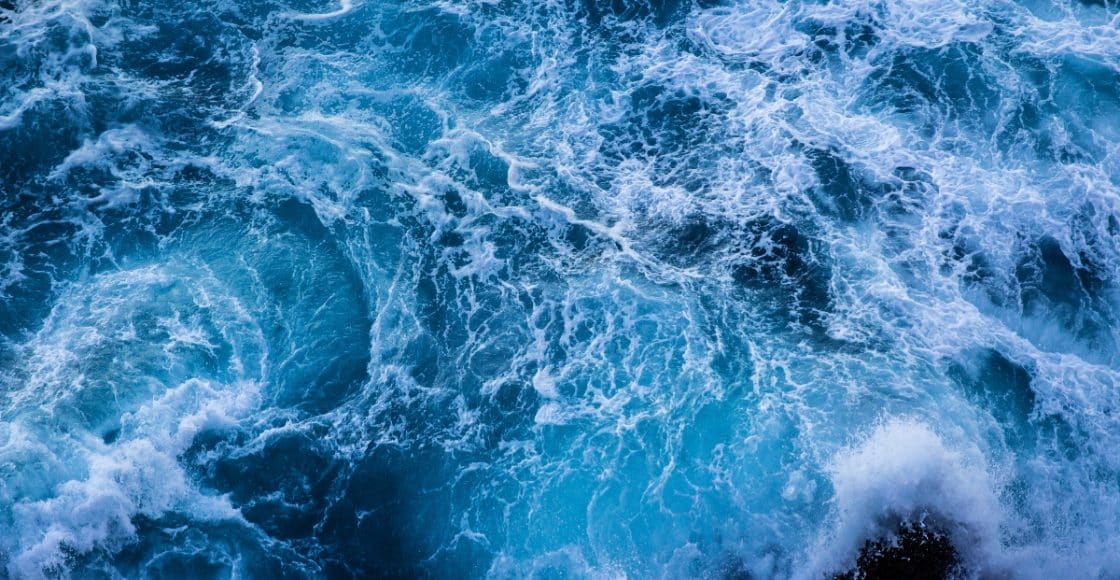
Best Boats for Rough Water: 6 Qualities that Make for a Smooth Cruise

Table of Contents
Last Updated on December 13, 2023 by Boatsetter Team
Most boats will perform well on calm water but when the sea kicks up, there are a few design elements that ensure a more stable ride. Some of these characteristics are tradeoffs with other features but if you boat on rough, choppy or offshore waters, consider a boat with one or more of the following features. In this post, we’ll highlight the six qualities you’ll want to keep an eye out for when sifting for the best boat:
- Two (or three) hulls
- More deadrise at the forefront
- Stiff heavy hulls
- 4:1 (length-to- beam ratio)
- Center gravity & draft
- Boats with high horsepower
20,000 boat makes & models to browse on Boatsetter
1. Two (or three) hulls
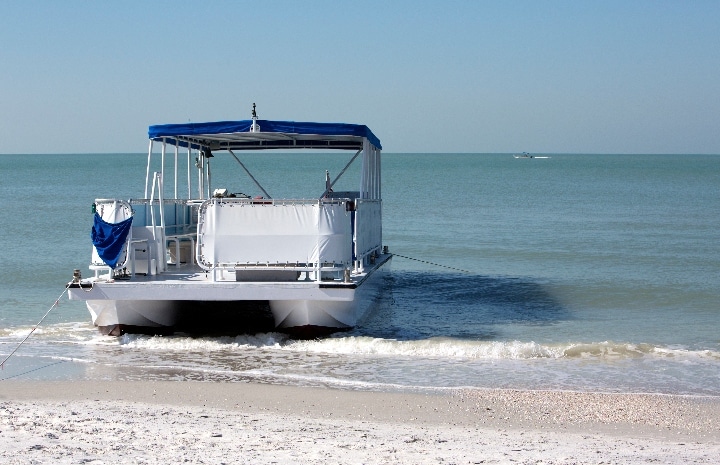
The hull is the portion of your boat that rides both in and on top of the water. Two (or three) hulls are generally more stable than one because they make a beamier (wider) boat. A monohull fishing boat for example, will roll more than the same length power catamaran and that leads to fatigue after just a few hours of angling. Boats with a broader beam tend to be steadier at speed and especially at rest and that makes a world of difference when you’re casting or cruising. Besides, multihulls also offer more deck space to work with so look for multihull models from World Cat, Aspen, Invincible and others.
The benefit of the beam also applies to pontoon boats, especially tritoon (three tube) models that can take a two foot chop in stride. Godfrey, Bennington, Manitou and other builders offer strong boats that can fly across a windy lake with ease.
2. More deadrise at the forefront
Monohull boats with a deep-V or more deadrise at the forefoot will track better and pound less than flat bottom vessels. Deadrise is the angle between the bottom of the hull and a horizontal plane. Optimum angles are 20-24 degrees for a soft ride when going into head seas. Regal, Sea Ray, Sabre and others specialize in building deep-V boats that can venture out in sketchy weather.
Flared or “Carolina” bows also help keep the decks dry. Bow flare will part water spray and toss it to the sides rather than onto the driver so you can go faster in big waves and stay comfortable. Sea Hunt and Skeeter make boats with plenty of flare.
Hulls with a higher freeboard are generally drier than those with lower decks. Freeboard is the distance between the waterline and the gunnel . Rough waters can swamp low vessels like flat boats but higher gunnels provide an extra measure of protection. Yellowfin and Everglades build models that make boaters feel safely ensconced within the boat in big seas.
3. Stiff heavy hulls
It’s no secret that heavier boats ride smoother regardless of the sea state. Displacement boats (rather than those that plane like watersport boats ) will part the seas or lift with oncoming waves rather than skitter across and get tossed around by rough water. Stiff, heavy hulls with stringer reinforcement will perform better and stay more stable. Grady White and Boston Whaler are good choices, although the heavier the boat, the more horsepower it takes to move it.
READ MORE: How to Plan for a Boat Trip
4. Length-to-beam ratio (4:1)
Longer waterlines bridge waves better so boats glide rather than bob in a chop or swell. A boat with a length-to-beam ratio of 2:1 will be more difficult to drive than one with a ratio of 4:1. A 40-foot boat with a beam of 10 feet should cut through the water without trouble. Cape Horn and Axopar build boats that slice through water like knives.
5. Center of gravity & draft
The lower the center gravity of a vessel, the more likely it will stay upright with little effect from waves or high winds. Most weight on a boat is provided by the keel , the engine(s), tanks, and batteries, which all act as ballast that stabilizes the craft. Keep in mind heavy T-tops or flybridges raise the center of gravity, so if you’re seasick or unsteady on your feet, steer clear of the highest point on a boat.
A deeper draft also helps keep a boat upright. Displacement hulls with longer and deeper keels are more comfortable in heavy seas than boats with a shoal keel. Passage makers like Nordhavn, Ocean Reef, and Grand Banks are good examples, but they are slow-moving long-distance cruisers rather than planning speedsters.
Pro tip: Renting a boat is a sweet alternative to boat ownership. As a Boatsetter Renter, for example, you find boats by your favorite brands and even boat types such as yachts , sailboats , cruisers , and more !
6. High horsepower
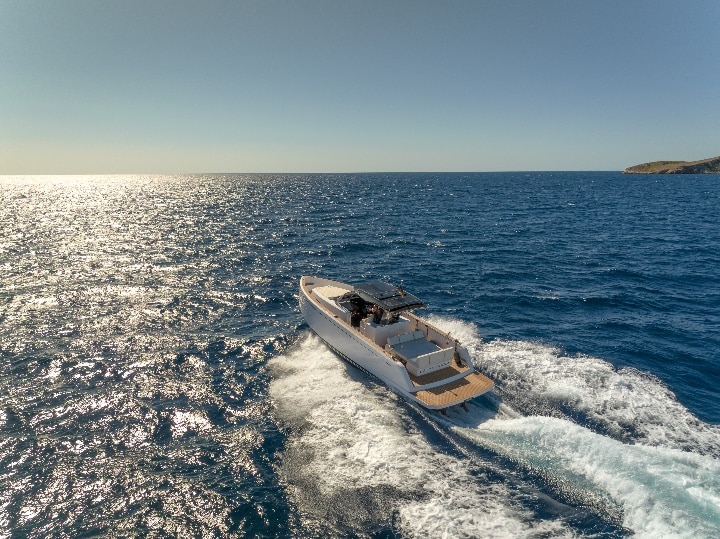
Finally, higher horsepower boats are usually better for rough water because they add weight down low and push through a sea state with more power. If you need to run from a storm or make it to a sheltered anchorage quickly, larger engines are a must. Inboard engines sit low in the hull and outboards add weight to the stern of boats and are kicked around less in following seas. Examples include any boat with multiple outboard or inboard engines.
Buoyancy is key to keeping a boat moving on her lines as much as possible. Self-draining cockpits with scuppers keep the water out of the boat so it doesn’t become weighted down and sluggish. Most open and express boats will have multiple scuppers for safety.
Beyond basic design
The above elements are basic to naval architecture, and all contribute to a safer, more stable vessel. However, don’t forget to look at a boat as a whole. Does it have shock-absorbent seating at least for the driver? Does it have a good windshield and cabin protection? Are there adequate handholds along the entire length so you can move forward and aft safely in a seaway? Assess the seaworthiness of a boat using many variables before heading out in rough water.
Boatsetter is the go-to app for boat rentals and on-water experiences. Whatever the adventure, we’ve got a boat for that—Set sail , start the party , go yachting , make your trophy catch , and hone your watersports skills! Download the Boatsetter app ( App Store | Google Play ). Make sure to follow @boatsetter on Instagram, and tag us in all your boat day pictures for the chance to be featured.
Rent. List. Share—Only at Boatsetter

Zuzana Prochazka is an award-winning freelance journalist and photographer with regular contributions to more than a dozen sailing and powerboating magazines and online publications including Southern Boating, SEA, Latitudes & Attitudes and SAIL. She is SAIL magazines Charter Editor and the Executive Director of Boating Writers International. Zuzana serves as judge for SAIL’s Best Boats awards and for Europe’s Best of Boats in Berlin.
A USCG 100 Ton Master, Zuzana founded and manages a flotilla charter organization called Zescapes that takes guests adventure sailing at destinations worldwide.
Zuzana has lived in Europe, Africa and the United States and has traveled extensively in South America, the islands of the South Pacific and Mexico.
Browse by experience

Explore articles

Celebrate New Year's Eve on a Boat: 4 Tips to Start Planning

Lake Travis Water Activities
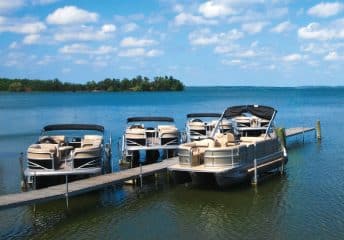
Docking a Pontoon Boat: 6 Easy Steps
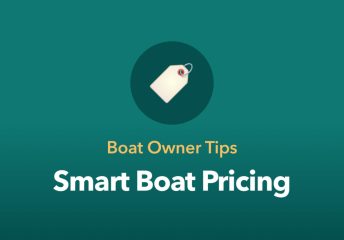
Smart Boat Pricing
Log in or Sign up

You are using an out of date browser. It may not display this or other websites correctly. You should upgrade or use an alternative browser .

PacBlue Senior Member
There are lots of marketing videos of yachts running in smooth calms seas, pretty to look at but I like to see the footage of when the weather pics up. Here is a good example when the weather turns: Would like to see more of this, commercial, naval and cruise ships need not apply.
DBowman78 Senior Member
Here's one of Kogo:
That was great, 2 things: That pilothouse is really far forward on Kogo and man, that takes a lot of nerve/skill to get a Pilot Boat that close, too bad we did not see the transfer of the Pilot Captain to the megayacht.
jsschieff Senior Member
Interesting to see how these yachts with traditional, flared bows take big head seas. The flare clearly keeps the bows from plunging dangerously deep. I wonder how modern plum bow or scythe bow yachts with little flare cope with rough seas like in the videos?
I wonder the same. Naval architects got away from those types of bows years ago for better heavy seas seakeeping albeit at the expense of higher slamming loads. Then the designers/stylists brought back the plumb bows and while they have lower bow accelerations they must be wetter than a blown fire hydrant, better have a heavy duty wiper system onboard. Would love to see video of them in seas like above.
YachtForums Administrator
If you search threads on YF from the mid to late-2000s, I think you'll find our members may have influenced current design trends, such as plumb bow benefits. Good videos above. A reminder that we're all at mercy of the sea.
GhostriderIII Senior Member
DBowman78 said: ↑ Here's one of Kogo: Click to expand...
gr8trn Senior Member
It would be cool to see recreational boats in more conditions. Sail and motor. Maybe it takes too much time and money to get all of the right conditions and gear in place. This is a decent test condition of a popular manufacturer that is more like reasonable conditions that one would be encountering with decent weather routing and decision making.
cleanslate Senior Member
PacBlue said: ↑ There are lots of marketing videos of yachts running in smooth calms seas, pretty to look at but I like to see the footage of when the weather pics up. Here is a good example when the weather turns: Would like to see more of this, commercial, naval and cruise ships need not apply. Click to expand...
NYCAP123 Senior Member
I've gone on many sea trials with buyers, and I think the brokers hated me. They'd always try to run in flat seas and I always pushed for rough. If nothing else I'd find wakes to cross at bad angles. That boat in the first video was running nice. The 2nd one? Yeah, hobby horse is a good description. It almost looked like the fault of that bulbous bow.
Capt Ralph Senior Member
NYCAP123 said: ↑ I've gone on many sea trials with buyers, and I think the brokers hated me. They'd always try to run in flat seas and I always pushed for rough. If nothing else I'd find wakes to cross at bad angles. That boat in the first video was running nice. The 2nd one? Yeah, hobby horse is a good description. It almost looked like the fault of that bulbous bow. Click to expand...
rtrafford Senior Member
My most recent sea trial on the buy, owner had no idea of my intent to gut and refurbish to the gills. He ordered up a cook with a really nice lunch served aboard while we trialed. My surveyor was in the engine room weeds, knowing full well that my aim was to have reliance upon major propulsion items, not nuance items. Surveyor knew I was going to tear her down. I knew Hargrave boat was well designed structurally. I enjoyed my lunch. I kicked hard at out-of-water, and knew he'd choose to close. Fun day. We were tearing her apart on the hard before escrow even cleared. Thread brought back a fun memory.
ApreMare Senior Member
I’ve seen the Gene machine roughs seas video before and I’m glad someone started this thread. My question is during a crossing like that what does the crew do with all the hundreds of loose furniture items, decor objects etc. Just imagine a showcase on a mag of a yacht like that and try to remember all the stuff you see and imagine that yacht running in rough conditions with all those items. Would love to know from someone in the business. I’ ve chartered many times albeit never a yacht that big, but also never did a crossing longer than 2-3 hours and not with rough seas. Thanks for all the replies, stay healthy.
ApreMare said: ↑ I’ve seen the Gene machine roughs seas video before and I’m glad someone started this thread. My question is during a crossing like that what does the crew do with all the hundreds of loose furniture items, decor objects etc. Just imagine a showcase on a mag of a yacht like that and try to remember all the stuff you see and imagine that yacht running in rough conditions with all those items. Would love to know from someone in the business. I’ ve chartered many times albeit never a yacht that big, but also never did a crossing longer than 2-3 hours and not with rough seas. Thanks for all the replies, stay healthy. Click to expand...
chesapeake46 Senior Member
ApreMare said: ↑ ....My question is during a crossing like that what does the crew do with all the hundreds of loose furniture items, decor objects etc. Just imagine a showcase on a mag of a yacht like that and try to remember all the stuff you see and imagine that yacht running in rough conditions with all those items..... Click to expand...
The cross over of goods from land based structures to the yacht design world has killed off the functionality and seakeeping of yachts, trendy designers rule all the others can only drool
Although all cabinets will generally have locks they sometime don't hold. Moved a 60' Sunseeker down to Fl. once and the owner loved to eat. He had the 2 fridges packed. First day out we hit rough seas. Those fridges blew open and kept blowing open. What a mess. Duct tape is a wonderful thing.
Norseman Senior Member
NYCAP123 said: ↑ Although all cabinets will generally have locks they sometime don't hold. Moved a 60' Sunseeker down to Fl. once and the owner loved to eat. He had the 2 fridges packed. First day out we hit rough seas. Those fridges blew open and kept blowing open. What a mess. Duct tape is a wonderful thing. Click to expand...
Norseman said: ↑ Saw similar when I was operating a Johnson 70 fifteen years ago: Owner said I could take it out as much as wanted, invited my wife for cruise around the harbor in Fort Lauderdale, then a quick spin out the inlet in light conditions: Noisy downstairs, sent wifey down to investigate: The dishwasher had come lose and ripped across the floor boards. (Secured it, no further damage) The plasma TV jammed and numerous other headaches, boat was not commissioned right, or built by a questionable yard, or both. Click to expand...
- No, create an account now.
- Yes, my password is:
- Forgot your password?


Top 10 Tips for Handling Your Boat in Rough Seas
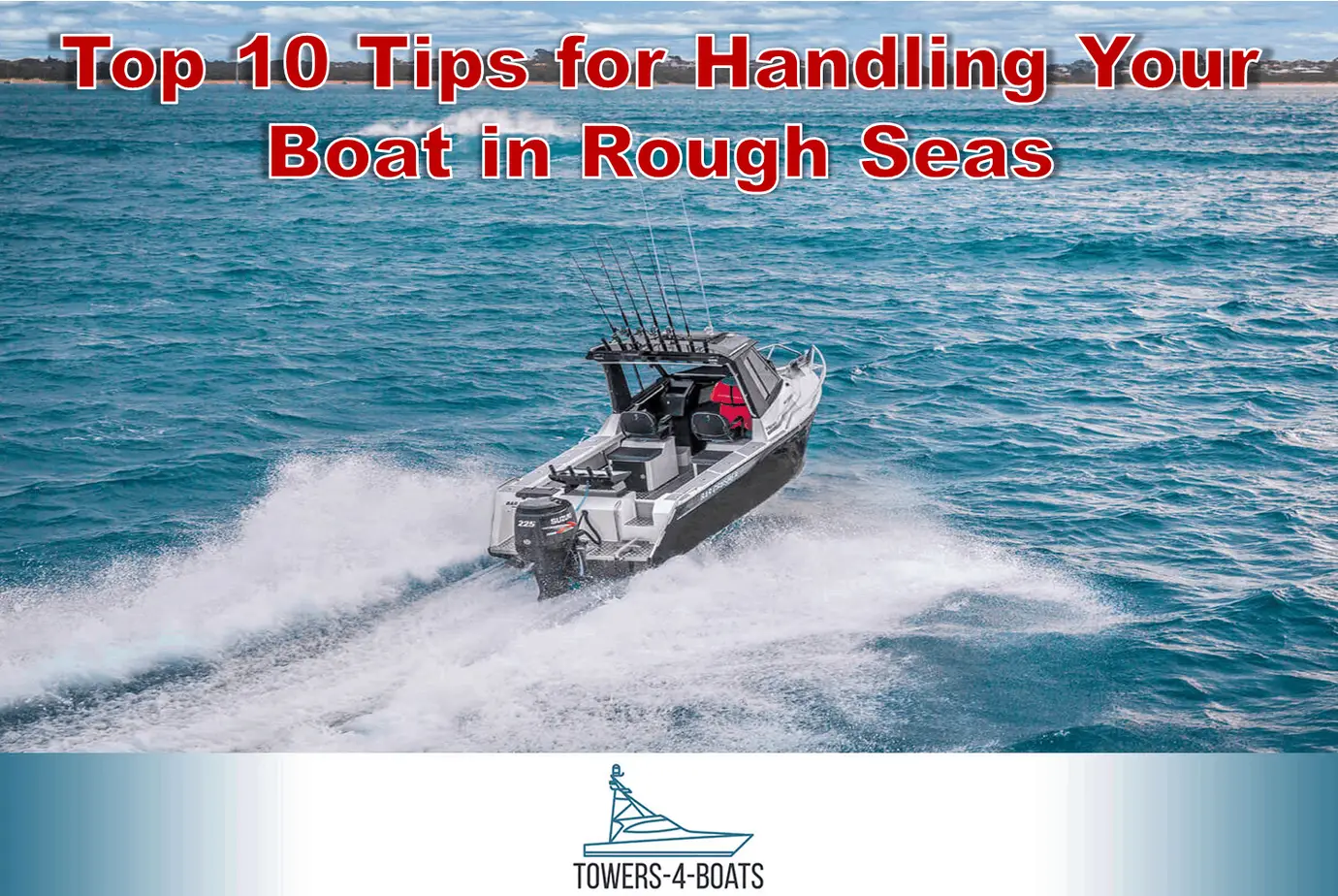
My Best 10 Ways to Boat in Rough Seas and Nasty Weather
When you’re out on the water, extreme weather and rough sea conditions can be a dangerous mix.
As alert, as you can be, you can still be caught by surprise by the weather and water.
Heatwaves bring high-pressure fronts in the summer boating season and can bring about storms quite suddenly.
And, particularly because you already know how to avoid and heal a wobbly stomach, there are worse things that can happen to you than getting seasick.
The good news is that you should take precautions to ensure that you don’t head right into a storm’s mouth where you’ll be boating in rough seas. And when you’re not in an optimal boating situation, there are steps you can take to remain healthy.
We will help you escape the more severe problems that rough seas pose here. You may also need to learn about safety considerations in addition to reading this article, such as basic boating navigation and having important safety items on board.
1 – Pay Attention to the Weather Forecast
I never go out on my boat without checking the weather. Even if I’m just planning to ski near the launch or marina. Wind knots are a tell-tale indicator of how big swells are going to get and whether you might experience whitecaps or not.
There are many free boating applications such as Windfinder and also desktop pages such as Wind Speed Convertors.
How to calculate wind knots from a wind speed converter.
- Capture wind speed, determined by an anemometer in kilometers.
- To get the mph of wind speed, divide the kilometers of wind speed by 1.61.
Ex: 100 kph ÷ 1.61 = 62 mph = 62 mph Ex:
- First, translate the wind speed from mph to feet per hour, then divide it by the number of feet per nautical mile.
Ex: 62 mph x 5280 ft = 327,360 hourly feet
327,360 hourly feet ÷ 6,076 feet = 53.8 knots
Note: a statute mile is 5,280 feet. A nautical mile is 6,076 feet.
And to note, the rough measurement of the distance of a thunderstorm in miles needs to be known:
(# seconds between thunder and flash) ÷ 5 = # miles away
2 – Wear your Personal Flotation Device
Be sure to put on lifejackets and USCG-approved PFDs if you encounter heavy seas. To send passengers flying overboard, all it will take is to strike a wave at the wrong angle. By having passengers sit in the middle and lowest section of the ships, this can be avoided.
And invest in some foul weather gear while on the subject. Cold rains and winds will also leave passengers soaked and chilled to the bone in poor weather conditions, resulting in hypothermia. Invest in hooded raincoats or ponchos, any moisture-wicking, and rapid-drying garments, and wear several layers or an additional set of clothing. The trick is to make sure your head, which releases the most heat, is protected.
3 – Fill Up Your Fuel Tank and Have an Emergency Kit
You should always have a boat emergency kit and some life-saving safety equipment, particularly if you’re on large or coastal bodies of water. That’s the time you can break those things out of lockers and get them close by while in rough seas. You have to do the following:
Have horns and instruments on hand for signaling.
- Turn on your VHF marine radio (check price on Amazon) and set it to international distress channel 16.
- Just in case you lose motor maneuverability near shallow water, rocks, or otherwise hazardous shores, prepare an anchor.
- Take the bailer bucket out in the event of water breach and spillage.
- Finally, pick up the Dramamine. I have a fairly good constitution and can withstand rough seas, but even strong stomachs can’t hack the choppiness of some monster swells.
4 -Reduce Your Speed and Turn on Navigational Lights for Visibility
Slow down and maintain the speed of your vessel! You will also need to tilt it at 45 degrees to minimize the effect of swells. It’s the best path, even if you’re not going straight to your destination.
Ask fellow travelers to have an additional pair of eyes when slowing down, alerting you of nearby boats and even debris. Even if you have 20/20 vision, nearby boaters can not! Torrential downpours and dense fogs will bring bad weather, so it is important to decrease speeds and maintain a lookout.
Also, you can switch your navigation lights on! These aren’t just for navigation at night, they’re there for foggy conditions too. This helps boaters to see the bow and stern of your vessel and from wading too close.
Riding too fast in rough seas and bad weather can make everyone seasick . Remember – your goal is to have fun, not win a race!
5 – Find Calmer Conditions – Change Course
If you have an app or a way to monitor the Doppler radar, you might be able to stay out of the path of the storm. Find shelter in other ways to find calmer situations if you can’t do so. In a pinch, bridges, coves and even the dock of a stranger will serve as large umbrellas and wind barriers.
Some boaters, if there is lightning, are afraid to go near bridges. But the logic behind this falls into another way of thinking: if lightning reaches the bridge you are under, it will fly back to the land in either direction along the bridge with already tiny chances. I’ll take those chances if it’s a severe enough storm!
6 – Disconnect Electrical Equipment
You need to disconnect all electrical devices if the storm has brought lightning with it. And don’t touch anything metal!
7 – Run With the Swells
If you find yourself caught riding the trough in the lower parts of the swells, take note! This will start to rock your boat and may probably cause it to roll. It may not target you in the direction you need to go, riding parallel with waves, and it may take you a lot longer to get home, but it is considered the safest way.
With a 45-degree angle within the trough, you might find more stability, too.
8 – Don’t Outrun the swells
You can outrun the waves occasionally by riding the crests, but it’s a fine line. Just remember: If it’s the wave or your vessel, it must come down to what goes up!
It is tricky to run ahead of the waves and can often lead to broaching, meaning you crash into the wave ahead, usually from too much momentum on your part, resulting instead in the wave behind moving the vessel sideways along the trough. And a sharp turnabout of broaching can lead to capsizing!
9 – Ride Out the Storm
If all else fails, the swells are high and your vessel is being thrown around so much you feel like you’re not going anywhere, don’t struggle against it. Just ride out that storm.
There’s only one technique you need for this: guiding the bow as much as you can into the swells and wind. You don’t want the swells to strike the hull any harder than they need to. The bow will break through the waves in this way and ease the effect (and your stomach).
You might even need to heave up if you’re low on petrol. You should deploy an anchor and use limited steering power while heaving to protect the fuel you have left to make it back to land when the storm lets up.
10 -Take a Boating Safety Course
Boating in rough seas depends on learning how to navigate your boat safely. Any of the above strategies are maneuvers that you can practice to become more prepared in calmer waters, but the best choice I can suggest is to sign up for a USCG Auxiliary Boating class (or two) such as Weather & Boating or a well-rounded course in Boating Skills and Seamanship.
The majority of water injuries are caused by human error. The more relaxed you feel handling your vessel, the easier it will be in rough seas to navigate boating .
Keep safe and relaxed and the sailing will be smooth!

You Might Also Like
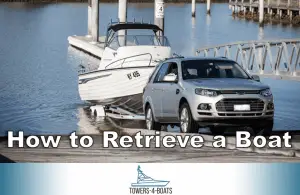
How to Retrieve a Boat

Tablet vs Chartplotter? Which is Right for Your Boat?
![yacht in rough seas Read more about the article Twin Outboards on Small Boat [Key Facts]](https://towers4boats.com/wp-content/uploads/2020/10/Twin-Outboards-on-Small-Boat-300x176.jpg)
Twin Outboards on Small Boat [Key Facts]
Practical Boat Owner
- Digital edition

Smoothing the cruising – a buyers guide to ‘shock-absorbing’ boat gear and more!
- Jake Kavanagh
- September 12, 2024
Former Motor Boat Monthly editor Jake Kavanagh explains the innovative gear available to help boaters cruise more comfortably and avoid the accumulative effects of shocks and impacts when using small vessels at high speed or in rough seas

If you can’t run to buying a set of hydrofoils, as seen on this striking boat from the UAE-based manufacturer Enata, there are plenty of more affordable alternatives
The ability to soften that slamming motion of a fast boat at sea has been greatly helped with more advanced and compact designs of shock-absorbing seating, self-adjusting trim tabs and internal/external stabilisers.
Costs are tumbling as equipment is being adapted from the burgeoning robotics, aerospace, and drone sectors, allowing boat owners to leave much of the ride control to fast-acting computers.
Even when mitigated, the constant movement of a boat in a seaway still requires the crew to brace themselves as their body accelerates and decelerates with each wave.
This bracing is very tiring, which is why the offshore industry is increasingly using foiling vessels to transfer crew to rigs and windfarms. The teams arrive fresh and alert, rather than tired and maybe a little seasick .
The more the boat can be made to glide through (or above) the waves rather than bounce across them, the more enjoyable high-speed boating will be.
Here is some of the equipment to help make the ride smoother, and which is relatively easy to retro fit.
Suspension ‘shock-absorbing’ seating
Suspension seating for leisure craft falls comes in two main types; ‘pedestal only,’ or a fully-fitted seat.

Suspension seating can start with a simple shock-loaded platform, as demonstrated with this Scandinavian 4S unit. You would simply bolt your favourite helm seat on top and secure the platform firmly to the cockpit sole

At the other end of the scale is the fully assembled and ergonomic seat, complete with full adjustment. This one is from US maker Shoxs, model 5005, and is intended for high-speed RIBs. Note the handlebars for passengers
Pedestal only
The ‘pedestal only’ concept allows an owner to attach an existing seat to a new platform, one contains a spring or gas filled shock absorber. There is a wide range of types and designs, some pre-set, some adjustable, and some able to swivel and lock.
The travel is usually between 6-8 inches, the amount of range needed to soften each landing without providing excessive movement for the passenger. Footrests can be added which can be adjusted to the passenger’s height.
Prices for a basic sprung pedestal can start at around £100, with fitting relatively straight forward. Sometimes this is just a straight swap of the base unit into existing holes in the deck and seat base.
Fully fitted seats
The second category is the fully fitted seat. Ergonomically padded upholstery is set into a frame that has springs or pistons installed to offer a far greater degree of comfort.
The designs include ‘Bucket’ ‘Jockey’ – a saddle arrangement for rigid inflatable boats (RIBs) – and ‘Trooper,’ but with variations on each theme. Originally the preserve of the professionals, for whom a rough sea was part of the job, this type of seating is now more widely available.
Costs have also come down due to more efficient manufacturing methods, more compact designs of mechanism, and a growing market, especially amongst US-based sports fishermen.
Some more enterprising PBO readers may be tempted to adapt the suspension seats from the likes of tractors, bulldozers and other off-road vehicles, and whilst this can prove successful in the short term, the non-marine materials involved can corrode quickly in salty air .
Buying a proper marine version tends to give a better return on investment, whilst also greatly increasing the enjoyment of high-speed or rough water boating.
Interceptors

Interceptors stab a small blade into the water and are very effective for trim control with no real loss of performance. They are supplied as a complete bolt-on unit, and only require thru-hull holes for a data cable and a power supply. This is Zipwake’s E Series
Interceptors are guillotine-like blades that stab down into the wake at the transom and prove remarkably effective at levelling the boat by reducing pitch, roll and yaw.
They can be provided as a boat-specific kit to fit the design of most transoms, but the real advantage is that they can self-adjust incredibly quickly. This smooths out the ride with speed and precision, at a rate way beyond the abilities of a human pilot.
This responsiveness, often involving dozens of adjustments per second, is due to the latest inertial sensor technology and powerful electric actuators.
Basically, in ‘auto’ mode the ‘brain’ will analyse data from a series of real-time sensors and then work the blades in rapid sequence to keep the boat running at its optimal angle .
Several companies are offering these units, but the leaders are Zipwake, Humphree and Seakeeper, the latter with its own take on the concept.
Gyro stabilisers

Gyro stabilisers have become increasingly compact. This unit from US-based Seakeeper and is designed for a boat of between 21-25ft.
Once again, the compact nature of the modern electric motor has allowed for marine gyro stabilisers to become remarkably efficient.
A large metal flywheel is spun – sometimes in a vacuum – at up to 15,000 rpm, and then reacts to any movement with immediate effect.
The gyro wants to stay upright, so as the boat moves beneath it, the gyro applies a powerful force in the opposite direction.
The result is to virtually eliminate rolling, converting it to more comfortable bobbing motion instead.
Gyros can be mounted almost anywhere on board, preferably along the centreline, and only require a standard 12VDC supply.
Larger models are often liquid cooled, whilst smaller ones are air cooled. The bad news is the price, starting at around £20,000.
Adaptive fins

The new and highly articulated All-In-One system from DMS fulfils many functions. The fins can be deployed as trim tabs for high-speed cruising…

…or stabiliser fins for mid-speed cruising…

…or ‘flapping fins’ for roll reduction at anchor
Stabiliser fins are also now more common on smaller powerboats, with self-contained motors and carefully designed blades.
Leaders in supplying the smaller cruisers are the Italian OEM CMC Marine, and the Swedish manufacturer Sleipner.
A very exciting development, due to be launched at the METS trade show in November this year, is the All-In-One from the Dutch specialist DMS.
This allows a set of fins to act as both trim tabs, high-speed stabilisers, or ‘zero-speed’ flapping foils to reduce rolling when at anchor.
Fins are still usually only found on boats upwards of 45ft but are also very effective at anchor.
As a guide to what is available, we have alphabetically listed some of the main manufacturers and the type of product they can provide.
Some have some great videos on their websites to show exactly how the forces are mitigated, greatly improving your enjoyment, and endurance, at sea.
SUSPENSION SEATING

Shockwave’s SW-S2-1200 midback helm seat with deckslide
Based in the US, Bentley’s manufacture the Mariner range of suspension seats, with single shock absorb ers for crew of up to 250lbs, and double shocks for those above. Other products include a swivel base that locks every 90 degrees. Bentleysmfg.com
SCANDINAVIAN SUSPENSION SEAT SYSTEMS (4S).
Manufacturer of a wide range of base units, in a choice of sizes and finishes, to which the boatowner can attach their own marine seats. This company also produces complete saddle seats for RIBs. Seatsuspension.systems
Based in Canada and founded in 1965, Shockwave supplies both the commercial and recreational sectors with high performance seating, including high-back seats and swivel bases. Products such as the Accuride provides immediate confirmation that the shock absorbers are set correctly to the passenger’s body weight. Shockwaveseats.com
SHOXS/KINETIX
US-based manufacturer of the Shoxs and Kinetic brands, and a major supplier to military, professional and recreational sectors. Products range from simple pedestals to bucket, jockey and troop suspension seating. Shoxs.com
SMOOTH MOVE SEATS
Aimed mainly at the sports angler, this Minnesota-based manufacturer provides two different suspension kits, the air and ultra-smooth. The company says both kits are extremely simple to mount, install and adjust and carry a three-year warranty. Smoothmoveseats.com
ULLMAN DYNAMICS
Founded in 1984 in Sweden by Johan Ullman MD after serving aboard a destroyer and noticing that 80% of the crew of torpedo boats suffered with back problems. The company now makes suspension jockey, bucket and bolster seats along with a series of cockpit accessories. Ullmandynamics.com
INTERCEPTORS

Zipwake’s E and S series of interceptor are part of a fully integrated system which acts as a ‘trim autopilot’ to smooth out the cruise
BENNETT MARINE
Founded in the US in the 50s, Bennett Marine is named after its founder Charles Bennett and is a manufacturer of remote-controlled trim tabs. www.bennetttrimtabs.com
A team of specialist hydrodynamic marine engineers founded Humphree in Sweden in 2002. The company produces stabilizer fins, interceptor trim blades and active stabilization electronics. www.humphree.com

Humphree’s Lightning design features a built-in 25W underwater light and full remote monitoring via a dedicated touch screen. It can also be controlled via an HTML5 link to an Multi-Function Display (MFD)
VOLVO PENTA
Volvo Penta produces the QL interceptor-style blade system in two versions – QL300 and QL 450 for high performance boats. The systems have an automatic levelling function. www.volvopenta.com
Based in Sweden and established in 2011, Zipwake was developed to connect own brand interceptor blades to gyro sensors for fully automatic trim control. The product is plug and play and aimed at the new build and retrofit market. www.zipwake.com
GYRO STABILSERS

The Italian OEM Quick has recently added to its range of compact MC2X of compact stabilisers, which now has 9 models
Based in Italy, Gyromarine is a single product company founded by a group of businessmen with experience in large engineering projects involving gyroscopes. Their advanced ‘driven’ system is aimed squarely at the superyacht market. www.gyromarine.com
A large marine manufacturing company, Quick S.p.A. was founded in Italy in the early 1980s, and produces a wide range of nautical hardware, with further manufacturing in the US. The MC2 X range of gyro stabilisers is available in 9 models. www.quicknauticalequipment.com
Based in California, USA, Sea Keeper manufactures a comprehensive range of gyro stabilisers from a 12V model for small craft (24ft) to versions for vessels of up to 85 feet/100 tons. Sea Keeper also provides models for the commercial market. www.seakeeper.com
Founded in 2014, Smartgyro is based in La Spezia (SP), Italy. The company is designing and developing a full range of highly advanced gyro stabilizers for recreational and commercial marine applications. www.smartgyro.com
FIN STABILSERS
Founded in Pisa, Italy in 2005, CMC manufactures a range of bow thrusters and fin stabilisers, with the Stabilis Electra system heralded as the world’s first electrically actuated fin. www.cmcmarine.com
DMS (Dynamic Marine Systems)
Established in Holland in 2013, DMS introduced the Anti-roll retractable stabilizer for yachts above 30m. This was followed by the MagnusMaster rotary system, and later by the All-In-One foiling system. www.dmsholland.com
Sleipner Motor AS was founded in Norway in 1908 to manufacture engines and propellers. Sleipner’s Sidepower brand now manufacturers thrusters, stabilisers and all the associated electronics in house. www.side-power.com

The Norwegian manufacturer Sleipner has recently upgraded its popular Vectis range of electric fin stabilisers with a new blade design. This has proved more effective at anchor and prevents the boat ‘paddling’ forwards
Vetus was established in the Netherlands in 1964 and has a wide portfolio of equipment with the aim of providing completely compatible systems. A range of stainless-steel fin stabilisers is available in 7 models. www.vetus.com

Boaters warned to mitigate against ‘shocks and impact’ in small vessels
Accumulative effects of shocks and impacts to boaters using small vessels at high speed or in rough water have been…

Cruising in powerboats long distance: a quick guide
When cruising in powerboats, especially small open boats, safety is paramount. Jake Kavanagh shares his advice for relaxed high-speed adventures…
Want to read more practical guides like Smoothing the cruising – a buyers guide to ‘shock-absorbing’ boat gear and more!?
A subscription to Practical Boat Owner magazine costs around 40% less than the cover price .
Print and digital editions are available through Magazines Direct – where you can also find the latest deals .
PBO is packed with information to help you get the most from boat ownership – whether sail or power.
- Take your DIY skills to the next level with trusted advice on boat maintenance and repairs
- Impartial in-depth gear reviews
- Practical cruising tips for making the most of your time afloat
Follow us on Facebook , Instagram, TikTok and Twitter
Sailing yachts like Mike Lynch's are 'unsinkable bodies', CEO of boat manufacturing firm says
Bayesian superyacht which sank off Italy is an "unsinkable" vessel, Giovanni Costantino, CEO of The Italian Sea Group, said.
By Ashna Hurynag, news correspondent and Eleonora Chiarella, producer
Sunday 25 August 2024 08:48, UK
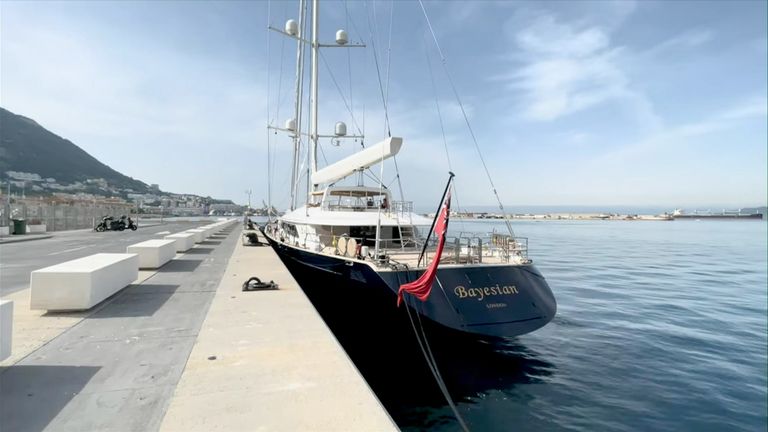
Vessels like Mike Lynch's stricken superyacht are "unsinkable", according to the chief executive of the firm which makes and sells them.
Giovanni Costantino, CEO of The Italian Sea Group, told Sky News there are no flaws with the design and construction of the Bayesian superyacht which capsized in a storm off the coast of Porticello, Sicily, on Monday.
Five bodies were found by divers on Wednesday - taking the number of confirmed dead to six.
The Italian Sea Group also owns the firm that built British tech tycoon Mr Lynch's Bayesian, and Mr Costantino said the vessels "are the safest in the most absolute sense".

"Being the manufacturer of Perini [boats], I know very well how the boats have always been designed and built," he said.
"And as Perini is a sailing ship... sailing ships are renowned to be the safest ever."
He said their structure and keel made them "unsinkable bodies".
Read more on this story: Why search of superyacht wreck has been so difficult Hero mum 'slept with baby on deck when storm sank yacht'
Be the first to get Breaking News
Install the Sky News app for free

Mr Costantino said news of the sinking "put me in a state of sadness on one side and of disbelief on the other".
"This incident sounds like an unbelievable story, both technically and as a fact," he said.
It is understood Italian prosecutors investigating the incident are continuing to hold interviews with the survivors.
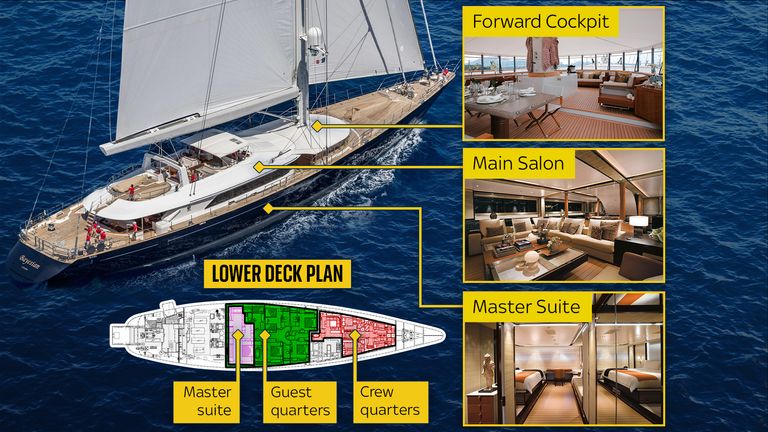
On Tuesday they questioned the captain for more than two hours to help reconstruct what happened and provide useful technical details.
Four British inspectors are also in Porticello and have begun a preliminary assessment of events.
It is understood they will look at all relevant aspects of the incident, including the design, stability, and operation of the vessel. They will also examine the effects of the weather conditions experienced.

Keep up with all the latest news from the UK and around the world by following Sky News
Twenty-two people were on board the vessel, 15 of whom were rescued - including Briton Charlotte Golunski and her one-year-old daughter Sofia.
Divers will resume efforts on Thursday morning to bring ashore a body they found earlier. One more person remains missing.
Related Topics
- Superyacht sinking

IMAGES
VIDEO
COMMENTS
Definitely not a good day for a cocktail cruise around the bay. This was the punishing sea-trial inflicted on the newly christened Enmer, a no-nonsense 75-foot XSV20 explorer yacht, before being ...
Subscribe before you goOn the Mighty Saint-Lawrence, just off shore from Sainte-Anne-Des-Monts Quebec, a luxury yacht makes way in rough seas, plunging and r...
Being in a yacht while the sea is rough can be a challenging experience, both physically and mentally. In fact, the motion of a yacht in rough seas can trigger the symptoms of seasickness, which include nausea, dizziness, and fatigue. The feeling of being tossed around by the waves can also be anxiety-inducing, causing a sense of vulnerability ...
1. Prout Snowgoose 37: This is a real blue water cruising boat that is perfect for experienced multi-hull sailors who have cruised across the Atlantic. It is also a great option for those who are new to sailing on rough seas. 2. Moore 24: Designed by the legendary California sailor and surfer George Olson, the Moore 24 is one of the first ultra-light displacement sailboats.
Watch this navy patrol boat facing rough seas, big waves and extreme winds (storm force 12) during a training exercise in the Southern Ocean in February 2021...
The Douglas Sea Scale defines 'rough seas' as 2.5-4m/4.1-8.2ft with very rough conditions being 4-6m/13-20ft. At Southampton University tank tests showed that when a wave was 30% as high as the hull length, it was possible to capsize some yachts. However a wave as high as 60% of the hull length capsized all vessels.
Hallberg Rassy are known for being heavy, sturdy, seaworthy boats. This video shows Hallberg Rassy 48 Elysium in heavy weather off Cape Gris Nez, northern France in 2014. The yacht seems to be ...
The best boat hull for rough seas must be able to handle following seas. "If you're going to have fine forward sections, you'll balance the hull by putting a lot of deadrise aft," Peters explained. "You're looking for recovery, a bow that doesn't plunge and that can regain its buoyancy in a following sea.
Here's day two through five of our Atlantic Ocean sail from Bermuda to Charleston. Check out the sunsets, horrific squalls, knock-downs, high winds, and what...
Best Multipurpose Stern: Bering B165. Turkish boatbuilder Bering Yachts revealed details of its new 162-foot flagship explorer yacht, the B165, at the Dubai International Boat Show in March. The ...
Strategies for Sailing in Rough Seas. Once your boat is properly prepared, it's time to set sail. Here are some strategies for navigating rough seas safely and effectively: 1. Choose the Right Course and Speed. When sailing in rough seas, it's important to choose a course and speed that will minimize the impact of the waves on your boat.
Less Stability: Yachts have a narrower beam, which makes them less stable in rough seas. Heeling: Yachts tend to heel or lean to one side in strong winds, making them more challenging to control. Slower Speed: Yachts are generally slower than catamarans, which can be a disadvantage when trying to outrun a storm. Catamarans
Knowing your boat's performance characteristics is also important in how to drive your boat in rough water, says Capt. Dan Stauffer, who runs charters out of Ocean City, Maryland, aboard a classic 31-foot Bertram with twin diesel engines. Stauffer says his hull handles predictably in rough seas yet is also relatively light for its size.
The result? A solution for performance, seakindliness, comfort, and safety in rough seas, all of which are readily apparent in the Surfhunter 25. "Hunt Yachts was created by me and a couple other partners," Willard further explains. "It was developed and then sold to Hinckley in 2013. We take pride in the boats that carry the Hunt name.
Rough seas and heavy wind are just a right of passage for many. I however would argue that the best sailors are those who manage to avoid heavy weather entirely. ... They say that the average sailor spends 10 hours working on a boat for every hour sailing and that's just about how it should be. Making sure everything is working and properly ...
Here are six potential conditions you could encounter in rough seas: Head sea: A sea that is broad on the bow, coming at an angle between the bow and amidships. Broad sea: A sea coming at you between the bow and amidships. Beam sea: A sea coming at a right angle to the keel of your boat. Quartering sea: A sea coming at an angle between amidships and astern.
Setting sail on a yacht is an adventurous experience, but it does come with its own set of challenges. This is especially true when yachting in rough waters or facing rough seas, which can be caused by inclement weather, water currents, and many other reasons.
6. High horsepower. Finally, higher horsepower boats are usually better for rough water because they add weight down low and push through a sea state with more power. If you need to run from a storm or make it to a sheltered anchorage quickly, larger engines are a must.
Browse 413 yacht in rough seas photos and images available, or start a new search to explore more photos and images. view on a rough sea, with waves of the open ocean from a boat - yacht in rough seas stock pictures, royalty-free photos & images.
1,994. Location: Dana Point, Ca. There are lots of marketing videos of yachts running in smooth calms seas, pretty to look at but I like to see the footage of when the weather pics up. Here is a good example when the weather turns: Would like to see more of this, commercial, naval and cruise ships need not apply.
10 -Take a Boating Safety Course. Boating in rough seas depends on learning how to navigate your boat safely. Any of the above strategies are maneuvers that you can practice to become more prepared in calmer waters, but the best choice I can suggest is to sign up for a USCG Auxiliary Boating class (or two) such as Weather & Boating or a well ...
Mastering the art of driving a boat in rough water takes practice, a fair amount of getting it wrong and sometimes a very wet boat and clothing. Our resident...
The ability to soften that slamming motion of a fast boat at sea has been greatly helped with more advanced and compact designs of shock-absorbing seating, self-adjusting trim tabs and internal/external stabilisers.. Costs are tumbling as equipment is being adapted from the burgeoning robotics, aerospace, and drone sectors, allowing boat owners to leave much of the ride control to fast-acting ...
HOW TO DRIVE A BOAT IN ROUGH SEAS - BIG OCEAN SWELLS!We are so excited we finally had the perfect weather day to film this video! This has been a pretty cons...
Sailing yachts like Mike Lynch's are 'unsinkable bodies', CEO of boat manufacturing firm says. Bayesian superyacht which sank off Italy is an "unsinkable" vessel, Giovanni Costantino, CEO of The ...